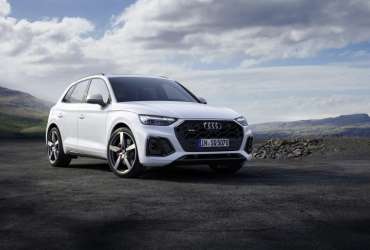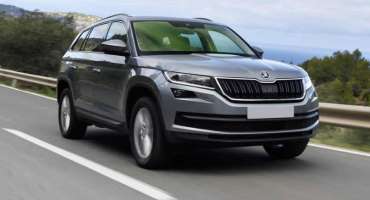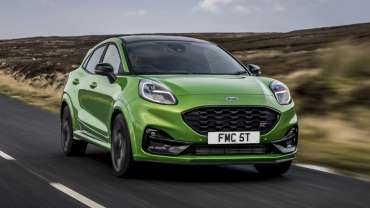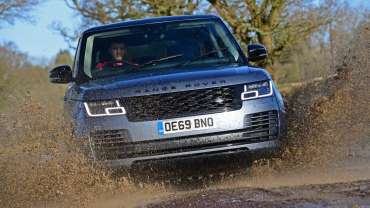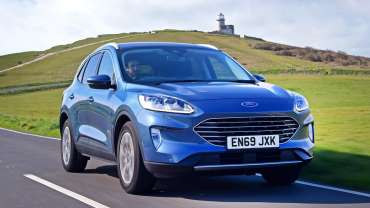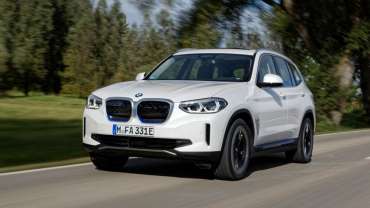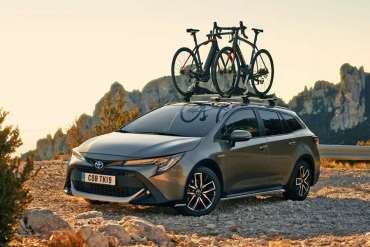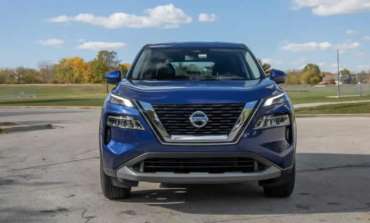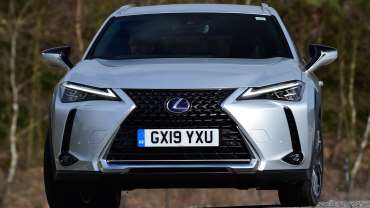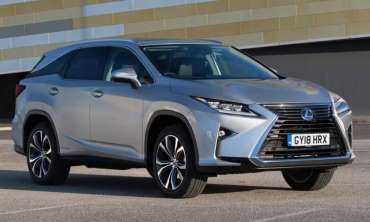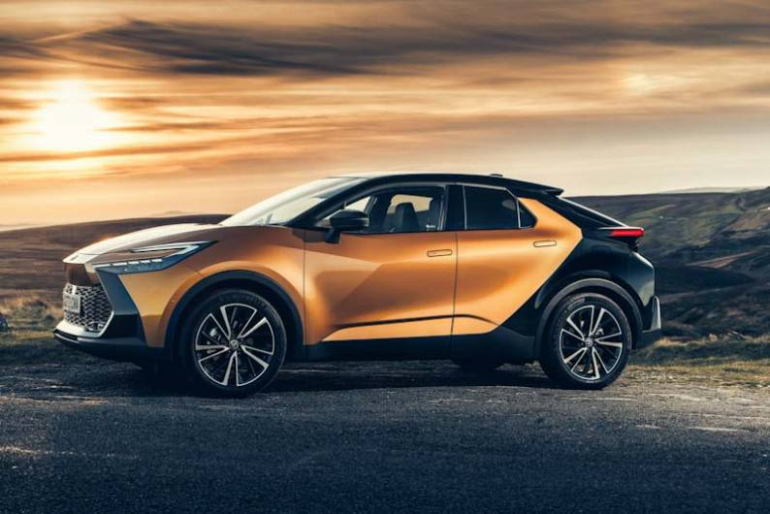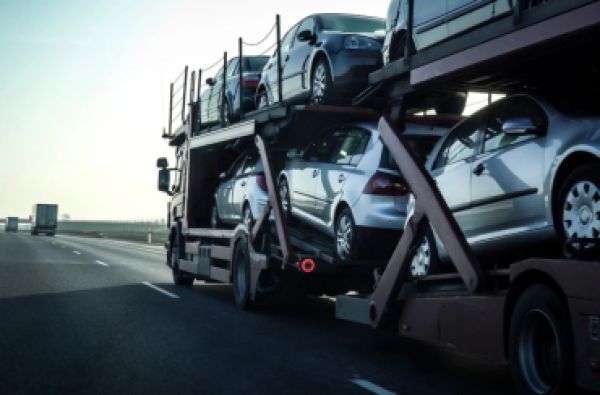Displaying items by tag: SUV
V6 TDI for gentleman: New Audi SQ5
Audi's best-selling model is the Q5 SUV. It was thoroughly redesigned in July, so that in September we could see its first ever "sportback" version. However, in Eastern Europe, a diesel with the prefix "S" was the most awaited. And not because of the purchase, but mostly because of mere enthusiasm. Well, here are the sweet numbers: 3.0, V6 TDI, 350 hp and 700 Nm; from 0-100 km / h in 5.1 seconds. But here are a few bitters: the starting price is almost 70,000 euros.
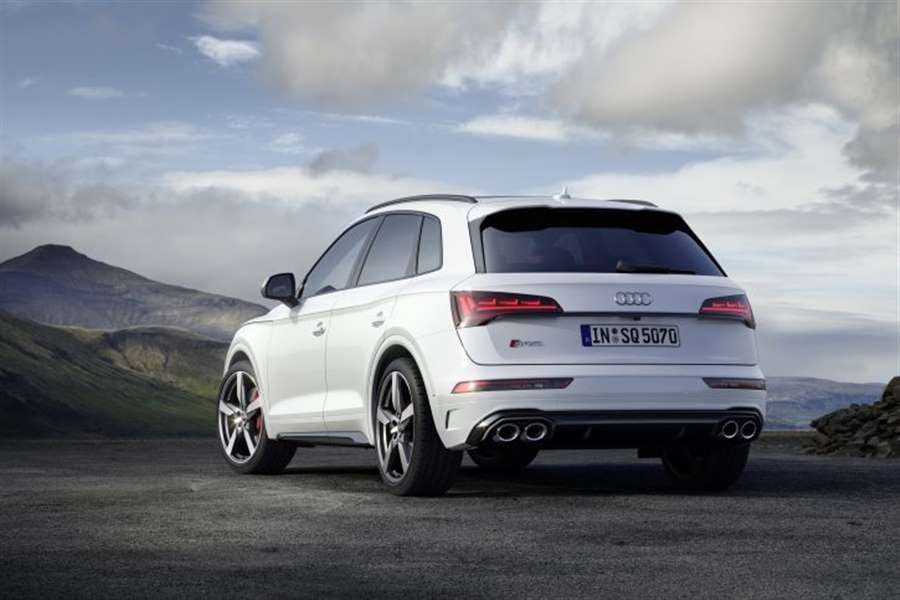
In addition to the powerful engine, the new "SQ5" got a more sporty look compared to the standard model: the front has a large octagonal grille and larger air intakes. And this version, at an additional cost, can be equipped with new OLED headlights and taillights.
These are digital diodes arranged in three parts, with six segments each, the display of which can be personalized, changed depending on the driving mode, and also reacts to dangerous traffic situations. By the way, LED matrix headlights come with the "SQ5" as standard.
At the rear, the changes are slight, while the four oval ends of the exhaust pipes stand out the most.
The cabin can be black, gray or red. The new Napa leather sports seats are adorned with the “S” logo, and also offer a massage option. The premium cab is enriched with brushed aluminum trim, while the top-of-the-line "SQ5 Vorsprung" offers carbon details.
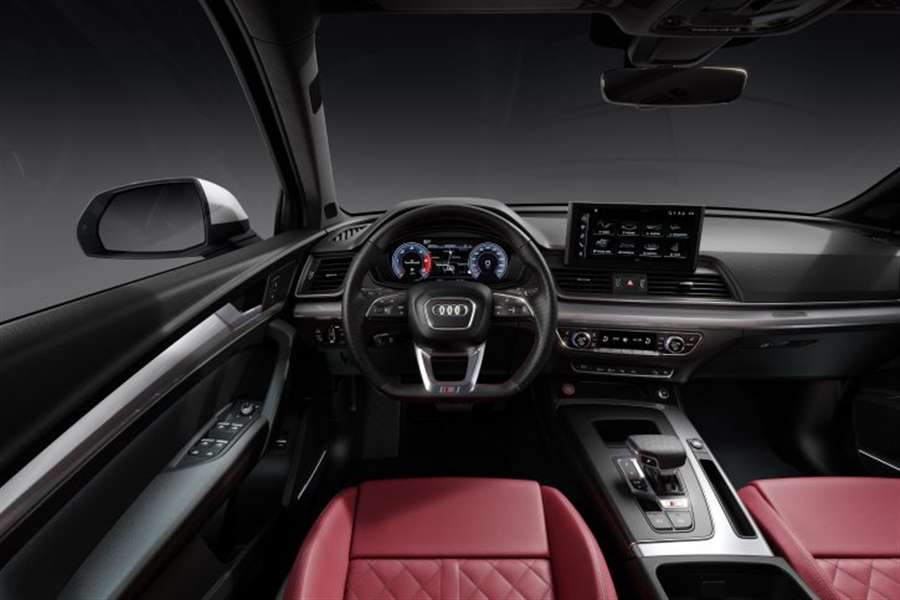
A novelty is the latest generation of MMI infotainment system (MIB3), which is displayed on a 10.1-inch screen. In front of the driver is a 12.3-inch digital instrument panel (Virtual Cockpit), and there is a "head-up" display. The functions in the vehicle are controlled in three ways: with the buttons on the steering wheel, via the touch screen or by voice.
As in the standard "Q5", there is plenty of space in the rear, and the practicality is emphasized by the option of moving the seat of the rear bench back and forth, while the backrests can be adjusted. The trunk has 520-1,520 liters.
As for the engine, it is a lighter and more efficient V6 TDI engine, with a volume of three liters, which uses advanced 48-volt mild hybrid technology.
Power is 350 hp, while 700 Nm of torque is now available at lower revs, between 1,750 and 3,250 rpm.
This 4.7-meter-long SUV reaches the "cattle" in just 5.1 seconds, while the top speed is 250 km / h.
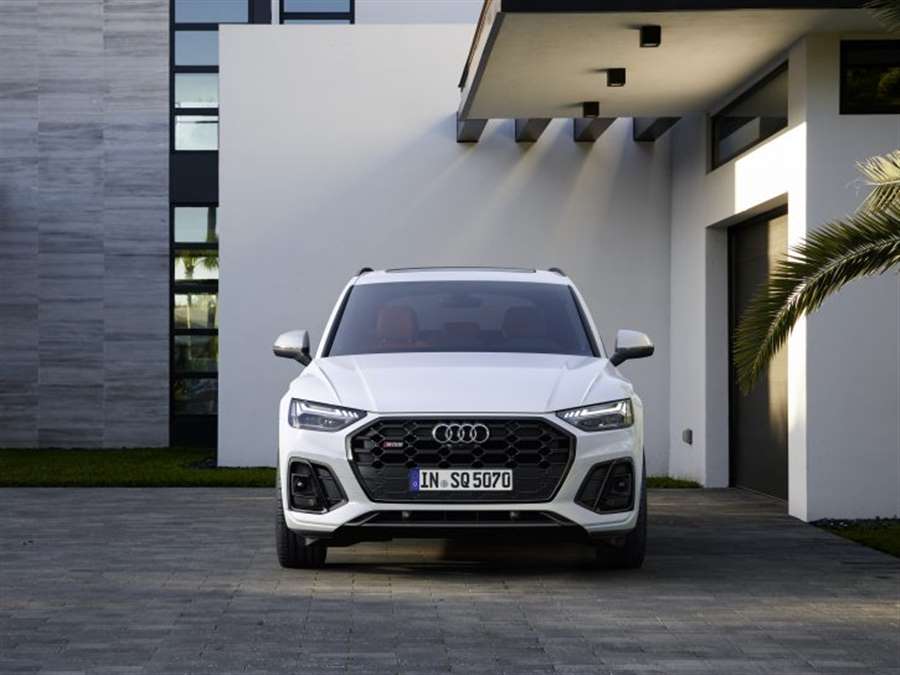
As before, the "SQ5" is 30 mm lower than standard and is equipped with sports suspension, as well as six different driving modes: Auto, Comfort, Efficiency, Dynamic, Off-road and Individual. With the "Vorsprung" version comes a sports differential on the rear axle.
The starting price for the "SQ5" in Germany is 68,138 euros.
Skoda Kodiaq Review
The Skoda Kodiaq is a big, practical family SUV that’s available with seven seats – although the rearmost two are only big enough for kids.
Is the Skoda Kodiaq a good car?
If you’ll forgive the tired cliche, the Skoda Kodiaq is like a Swiss army knife. It’s got all the tools to suit any situation, and once you’ve driven one, you’ll wonder what you did without it. It’s best aspect is its practicality, though, as it’s massive inside.
It’s a seven-seater SUV like the VW Tiguan Allspace and SEAT Tarraco, and it’s available in lots of configurations, from a diesel front-wheel-drive manual right up to a powerful four-wheel-drive automatic petrol called the vRS.
It’s not the biggest seven-seater, but it’s very roomy on the inside, but a seven-seater MPV like a Renault Scenic is slightly better for carrying lots of people around, because the rearmost seats in the Skoda are only useful for kids.
It’s at its best as a five-seater, because in that configuration there’s an absolutely enormous boot. In five-seat mode there’s room for everything you need for a family holiday with space left over, and with all the seats folded down, it’s van-like in there.
This is the first seven-seater Skoda has ever made, and it’s spot on for family life.
Mat Watson
carwow expert
The interior is practical too, with plenty of clever touches, but it’s also good quality. The plastics and materials used look and feel good, and build quality is high. It makes the Kodiaq feel a lot more upmarket than a Nissan X-Trail, for example.
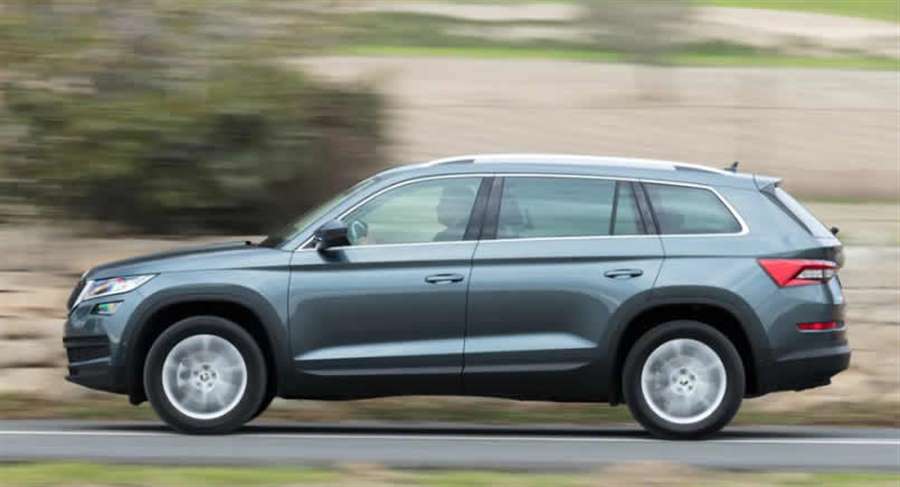
Plus, the Skoda Kodiaq is really easy to drive. There are some blind spots, but the high driving position gives a good view forward and the steering is very light. The same is true of the gearshift in manual models, and auto versions are even easier.
The suspension is a little firm around town at low speeds but it settled down nicely on the motorway, so the Skoda is comfortable overall. Versions on bigger wheels aren’t as comfortable so the lower-spec cars actually make more sense.
There’s a great range of engines to pick from, too. The 1.5-litre petrol model is a highlight, thanks to a good mix of performance and economy, but if you’re off-roading or towing in a four-wheel drive car, we’d go for the 2.0-litre diesel as it’s really torquey. The vRS model is fast but not all that fun to drive, so we’d stick with more pragmatic models.
A five-star Euro NCAP safety rating means it’s one of the safest SUVs around, so you can be relaxed about it acting as a family bus. Plus, a recent update added even more safety kit, including predictive adaptive cruise control, that steers, and adjusts your speed for you. It’s like finding another tool in your Swiss Army knife you hadn’t used before: once you know what it’s for you’ll wonder how you managed to live without it.
Read on for more information on the Skoda Kodiaq, or see how much you can save with these Skoda Kodiaq deals.
Common Skoda Kodiaq questions
Is the Skoda Kodiaq a 4×4?
Most versions of the Skoda Kodiaq come with four-wheel drive, but 125hp and 150hp petrol models and 115hp and 150hp diesel models come with front-wheel drive have to make do with front-wheel drive as standard.
Is the Skoda Kodiaq a 7-seater?
Entry-level Skoda Kodiaq models in S trim come with only five seats, but all other versions can be had with seven seats. Pick a high-spec Sportline or Scout version and you get seven seats as standard.
Where are Skoda Kodiaqs made?
The Skoda Kodiaq is built in six factories worldwide, but the majority of cars sold in Europe come from the firm’s Czech facility in Kvasiny.
Skoda Kodiaq interior
The Skoda Kodiaq’s dashboard is smartly designed and easy to use, but it doesn’t get the same high-tech features as the VW Tiguan.
Style
The Skoda Kodiaq interior is of good quality and feels well-built. The dashboard, doors and centre console are all covered in nice soft-touch plastics, while the seats – trimmed in suede-like Alcantara on high-spec SE L models – are supportive and help make the interior feel genuinely upmarket.
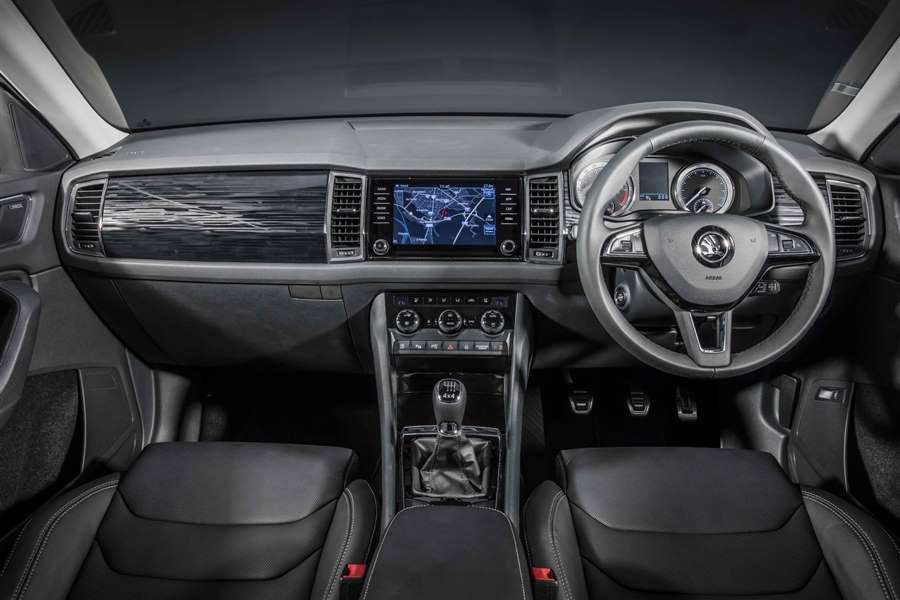
Everything is pretty easy to operate, too, as you’re not faced with a huge number of buttons; and, the knobs for the ventilation system and stereo volume are easy to operate when you’re on the move.
The standard infotainment system is operated through an 8-inch touchscreen, which is flanked by two banks of shortcut buttons and a pair of neat vertical air vents, while the gloss black wood-effect dashboard trims look great – even if they’ll scratch easily over time.
However, it’s not all good news: the second digital display in the instrument cluster looks significantly more dated – think Game Boy rather than iPad – and some materials in the rear feel brittle and cheap; but, in both cases, this is nit-picking.
Infotainment
Entry-level Skoda Kodiaq SE cars come with an 8-inch touchscreen infotainment screen. It’s sharp, bright and easy to read, and comes with a set of handy shortcut buttons to stop you getting lost in a sea of menus. Unfortunately, these buttons don’t buzz or click when you press them so you’ll have to occasionally take your eyes off the road to make sure you’re hitting the right ones.
A neat proximity sensor displays extra on-screen buttons when it detects your hand nearing the screen. This is especially useful when you’re using the built-in satellite navigation on SE L cars – it’ll flash up petrol station icons when you reach for the screen and hide them away automatically so you can see the map more clearly.
The standard sat-nav can rapidly calculate three route choices at once and you can swipe and pinch to zoom to preview its directions – just like using a smartphone. Unfortunately, the screen’s glossy finish shows up grubby finger marks like nothing else.
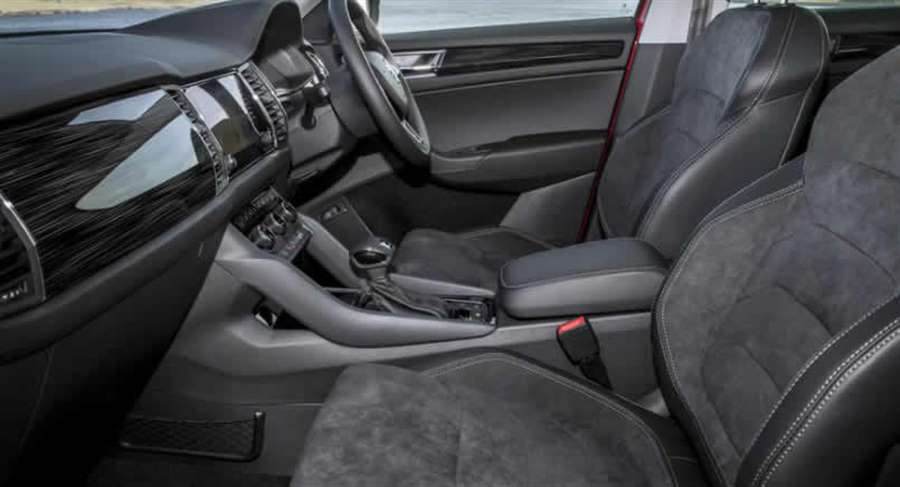
Happily, Android Auto, Apple CarPlay and MirrorLink connectivity to mirror your smartphone’s navigation on the built-in infotainment screen is standard on all Kodiaqs.
High-spec SE L models come with a larger 9.2-inch touchscreen infotainment system while top-spec Edition versions have a wireless smartphone charging feature that’ll also boost your phone signal.
Unfortunately, if you like to stream music from your phone, the standard stereo just isn’t up to scratch. The Skoda Kodiaq’s Bluetooth connection makes your music sounds tinny and bassless – things sound much better when you connect your phone using the USB port. Upgrade to the Canton sound system and you’ll be rewarded with much clearer and bassier tunes.
Ford Puma ST SUV review
"The Ford Puma ST is great to drive, has a brilliant engine and offers all the practicality of an SUV with hot hatch thrills"
We already liked the new Ford Puma because it’s a practical SUV that’s also good to drive, and now there’s an even sportier version, called the Puma ST, which has a more powerful engine and changes to make it sharper to drive.
Alternatives to the Puma ST include the Volkswagen T-Roc R and the Audi SQ2, although both are both much more expensive and more powerful than the Ford. Don’t assume that it makes them more fun though.
The Puma uses parts from the fantastic Fiesta ST hot hatchback, in particular the 1.5-litre EcoBoost three-cylinder turbocharged petrol engine. It produces 197bhp and 320Nm of torque, the same as in the Fiesta ST supermini, and there’s a six-speed manual gearbox, improved brakes plus suspension changes.
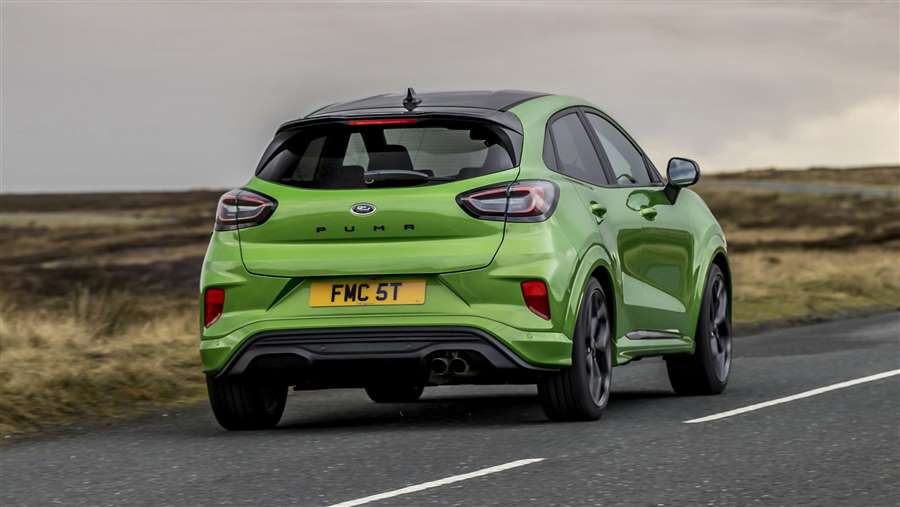
The Puma does drive differently to the Fiesta as it’s a larger car but this is also because Ford has designed it to be better at everyday tasks. It’s more practical than the Fiesta as a result, though not quite as fun to drive.
The Puma is still the best-handling small SUV you can buy and if you need an SUV but want the thrills of a hot hatch, then the Ford Puma ST could be a brilliant buy. Read on to find out more in our full review.
MPG, running costs & CO2
Since the Puma ST uses a three-cylinder 1.5-litre petrol engine, it’s actually fairly economical for a performance car. Don’t set your expectations too high, though, as the ST isn’t as frugal as the standard versions of the Puma.
Official figures suggest that the Puma will return 40.9mpg and emit 155g/km of CO2, which is better than the Audi SQ2’s 33mpg and the VW T-Roc R’s 32mpg. While those are all figures from official tests rather than real-world driving, we still expect the Puma to be more economical.
The Puma makes more sense than either of those models to buy; it’s around £10,000 cheaper than the Audi or Volkswagen, depending on specification, yet is more fun to drive than either of them.
Engines, drive & performance
One of the best-handling SUVs you can buy
Fast Fords are consistently excellent to drive and the Puma ST is no exception - in fact, we’d argue that it’s the most fun you can currently have in any small SUV.
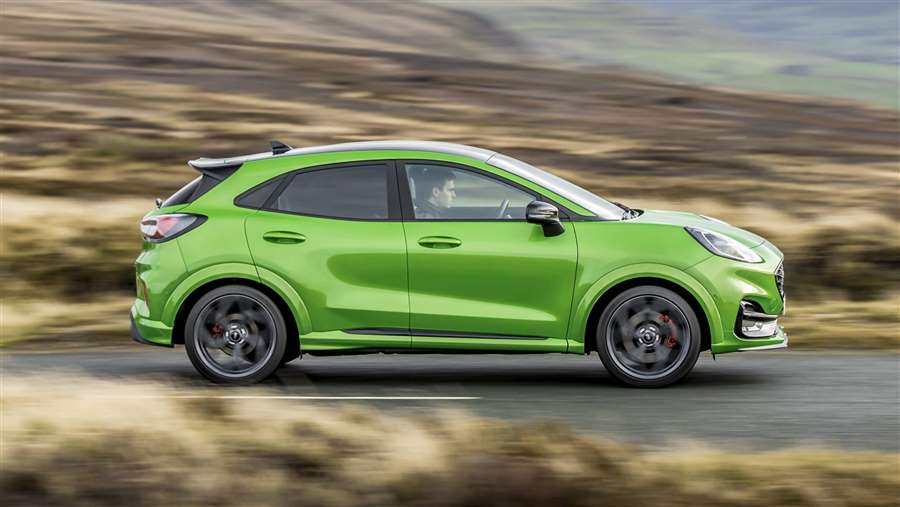
The ride can be a little bumpy at low speeds but once you’re going more quickly, the Puma ST is relatively smooth and feels at home on country roads. It’s great fun to steer through a series of bends on a twisty road.
The steering is very sharp, which can feel a little disconcerting because you can often turn it too much without meaning to. Once you get used to it, this is less of a problem, but it does feel slightly oversensitive.
Performance is very good: the Puma ST goes from 0-62mph in 6.7 seconds, which seems well-judged for UK roads because you can have plenty of fun within the speed limit. It’s not quite as quick as the smaller Ford Fiesta ST but outright straight-line speed is not what this car is about.
The rest of the driving experience is great too; the manual gear shift is fun to use, the pedals are nicely placed and the brakes feel strong and reliable.
Interior & comfort
Not the most comfortable Puma but comfortable seats make a difference
In the Puma ST you get some really supportive and comfortable Recaro sports seats as standard, which help to keep you in place when cornering. Larger drivers might find they’re a bit tight.
The ST also comes with a flat-bottomed steering wheel with ST badging, some new pedals and a different gearknob. You also get wireless charging for your smartphone, parking sensors, a 12.3-inch digital driver’s display and an eight-inch infotainment touchscreen with Ford's SYNC 3 software, sat nav, Apple CarPlay and Android Auto.
This makes the Puma ST one of the best-equipped models in the Puma range and while the interior does have some cheaper-looking plastics, the level of technology means it feels modern and pleasant inside.
Practicality & boot space
The Puma ST is just as practical as the standard version
All of the regular Puma’s neat practical touches are still present in the ST model, which is great to see. The fantastic ‘Mega Box’ is present in the boot - this is a huge storage compartment under the floor that’s big enough for a whole family shop.
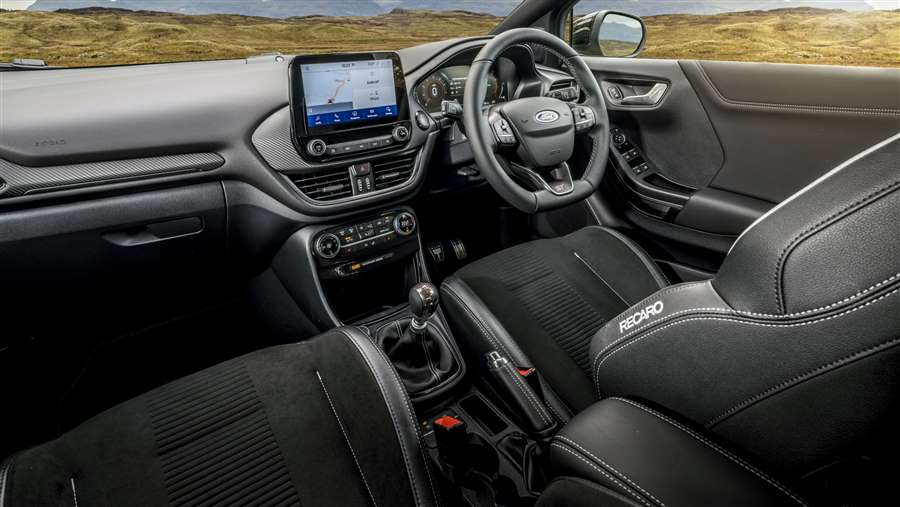
The boot itself is excellent at 456 litres, and the plastic floor means you can even hose it out - there’s a plug at the bottom of the Mega Box that lets water drain away.
Inside the Puma you’ll find a good amount of passenger space, though adults in the back might start to feel cramped on a longer trip.
Reliability & safety
High-performance Puma will match normal version for safety
The Puma ST takes the same Euro NCAP safety rating as the normal car - that being a five-star score with an excellent rating for adult protection. Thanks to autonomous emergency braking (AEB), lane keep assist and adaptive cruise control, it’s packed with safety kit.
Ford came in 24th place in this year’s Driver Power survey, which was disappointing as it’s near the bottom of the list. It indicates that, on average, the ownership experience isn’t as good as it is for many other brands.
Source: carbayer.co.uk
Range Rover SUV review
"The Range Rover is an SUV icon, built to be one of the most upmarket and comfortable ways to travel, whatever terrain you need to cross"
The latest evolution of the legendary Range Rover SUV would be almost unrecognisable to owners of the simple original model, which was designed to offer more comfort than the Land Rover on which it was based, but was still rather workmanlike.
Before long, the Range Rover was adopted by wealthy owners with sprawling estates, making it the 4x4 to be seen in – a fact cemented by the Royal Family being photographed driving them – and its utilitarian plastic interior trim was gradually made more luxurious, with wood veneer and swathes of leather.
Over the years, it’s been kept bang up-to-date, but one thing that has never changed is Land Rover’s commitment to the Range Rover being the most capable off-roader you can buy. To this end, even a top-spec Range Rover – with an interior as luxurious as a premium saloon car and destined to spend its life in Kensington – still has the technology to scale almost any mountain or ford any river.
The Range Rover has taken this concept to the next level, with a greater emphasis on exterior and interior design than before. Inside, the dashboard is uncluttered and simple, with attractive materials and a pleasant design. A 2017 update modernised the infotainment system, ushering in two screens on the central console but this now feels dated compared with JLR's latest infotainment in newer models like the Land Rover Defender. There's gesture control for the sunblind, LED headlights and an Activity Key that allows owners to leave the normal key in their Range Rover while wearing a rugged, waterproof bracelet version. Meanwhile, comfort for rear-seat passengers is better than ever – especially if you go for the long-wheelbase model.
Impressively, despite all these technological additions, the latest Range Rover is 420kg lighter than its predecessor, which improves performance and running costs. The P400e petrol hybrid is the cheapest to run, despite its impressive pulling power. For those that want a mild-hybrid, the P400 MHEV uses a 3.0-litre straight-six engine producing 395bhp. For higher mileage drivers who want a diesel engine, there’s the 3.0-litre D300 and D350, a pair of 'Ingenium' straight-six diesel mild hybrids introduced in 2020, with 296bhp and 345bhp respectively.
The other extreme is the 5.0-litre supercharged V8 engine with 518bhp or 557bhp, which you can also find in sports cars like the Jaguar F-Type. The most powerful version is exclusive to the SVAutobiography Dynamic, which is as menacingly raucous as you’d want. This model comes with a tuned chassis and has responses honed to be as close as possible to a Range Rover sports car. It manages 0-62mph in just 5.4 seconds, while passengers travel in unabashed luxury.
Managing the same 5.4-second 0-62mph time, the ‘normal’ 518bhp version of that engine is available on Autobiography models. That name signifies the top of the Range Rover tree, but you can still spend many hours poring over the options, colour combinations and accessories in the brochure – it’s easy to send the cost of this SUV deep into three figures. However, even the entry-level Vogue and Vogue SE models are well equipped, the opulent Autobiography versions compete with the Bentley Bentayga – the world’s most expensive SUV – for luxury and comfort.
While the off-road prowess and craftsmanship of the Range Rover aren’t in doubt, the marque has struggled for reliability in the past. Not enough owners provided details for the latest version to appear in our 2020 Driver Power customer satisfaction survey, but the Land Rover brand came a disappointing 25th out of 30 manufacturers overall, hampered by poor reliability and steep running costs. But we’d imagine few people buy a Range Rover expecting it to save them pennies and there’s nothing else on the road quite like it, with a stunning design and unique ability to sooth long journeys one minute and then canter up grass banks too steep for most horses the next.
Range Rover SUV - MPG, running costs & CO2
If you’re worried about fuel economy, chances are you’re probably not after a big luxury 4x4. The Range Rover is expensive to buy and run.
Despite Land Rover's best efforts to lighten the Range Rover, it's still an absolutely huge car and as a result, it's still heavy. Factor in the poor aerodynamics of its tall, boxy shape, and it's clear the Range Rover will struggle to deliver impressive economy and emissions.
While the latest Range Rover is the most fuel-efficient yet, we’re still talking about a car with a fair appetite for fuel. Even with a new design and mild-hybrid technology, the latest 3.0-litre D300 diesel claims an official fuel economy of 32.5mpg (WLTP) and CO2 emissions of 228g/km.
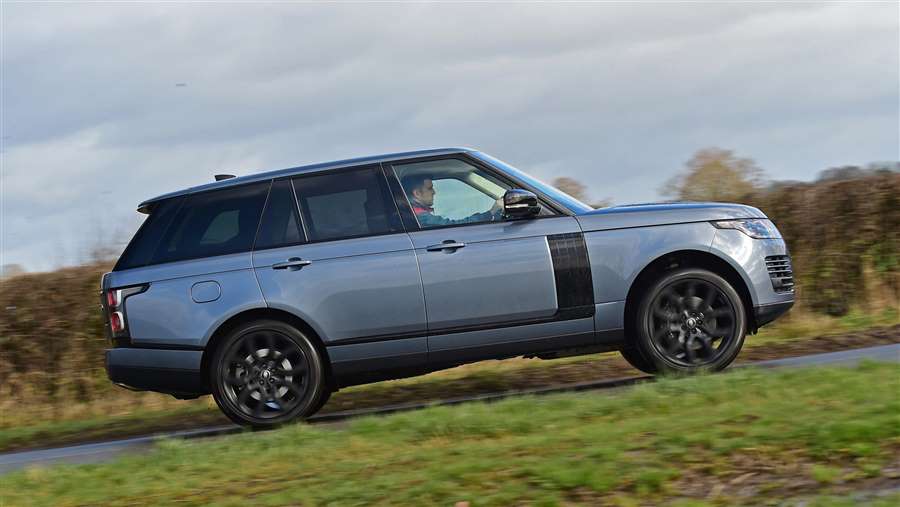
The more powerful D350 Range Rover, is even thirstier, managing 30.6mpg and 242g/km of CO2 - although this is an improvement on the SDV8 it replaces. If you want the ultimate in SUV performance, Land Rover says the 5.0-litre V8 petrol will do around 19mpg, but in everyday use, it's likely to be closer to 15mpg. However, you’re unlikely to find the economy much better in other high-performance SUVs like the Mercedes GLS 63 AMG, BMW X5 M or BMW X6 M.
The Range Rover P400e plug-in hybrid – which we've reviewed separately – combines a turbocharged 2.0-litre petrol engine and electric motor, providing an all-electric driving range of 25 miles on a full charge. Land Rover claims CO2 emissions of 77g/km and an average fuel consumption figure of up to 82.3mpg. The P400e brings significant Benefit-in-Kind (BiK) reductions for business users, being the only Range Rover not in the highest band. Unfortunately, though, its emissions mean it just misses the 75g/km cut-off for free travel into the London Congestion Charge zone.
A mild hybrid was introduced in 2019, the P400 MHEV is fitted with a turbocharged 3.0-litre straight-six petrol engine and a mild-hybrid system consisting of an electric supercharger and battery pack. It stores the energy normally lost under braking into the 48-volt battery. This power is used to improve the engine’s efficiency under load, assisting acceleration when starting off as well as improving the effectiveness of the stop start system. Land Rover claims this setup can achieve fuel economy of up to 26.4mpg and CO2 emissions of 243g/km - which isn't far off the efficiency of the D350 diesel engine.
With the exception of the plug-in hybrid version, every Range Rover is liable for £150 annual road tax from the second year. The P400e attracts a slightly reduced rate of £140. Again from the second year, all versions are liable for an additional surcharge of £325 for five years because they cost more than £40,000.
In terms of residual values, a rule of thumb is that the more expensive the model of Range Rover, the worse the depreciation will be.
Insurance group
Even Range Rovers fitted with sensible engines attract hefty insurance premiums. The cheapest model in the range – the SDV6 Vogue – is in insurance group 45 out of 50. As models get more expensive, they begin to move up the group rating system, with the V8 Autobiography and SVAutobiography models sitting in group 50, the most expensive insurance bracket. As ever, make sure to contact your insurer before making a buying decision.
Servicing
Land Rover says you should have your Range Rover serviced every 15,000 miles. Big engines have lots of spark plugs and other things that will need to be replaced, so it'll be a lot pricier to service than your average family car.
Warranty
There's a fairly generous three-year/unlimited-mileage warranty offered on the Range Rover. That’s pretty much average for this type of car, but the Toyota Land Cruiser comes out top here, with a five-year/100,000-mile warranty.
Range Rover SUV - Engines, drive & performance
Incredible off-road performance and towing ability when you need it, plus a comfortable limousine-like ride when you don’t
The latest Range Rover weighs 420kg less than its predecessor, which has a positive effect on handling and performance and for such a big, bulky car, it certainly doesn’t disgrace itself on a twisty road.
While all models handle surprisingly neatly, the SVAutobiography Dynamic shows exactly what the Range Rover can do. Sure, it won’t shrink around you and you’re always aware of the weight and bulk of what you’re driving, but with lowered ride height and modifications to the suspension and steering, fast corners can be taken with confidence.
Step into one of the SVAutobiography’s less muscular sisters and there’s a profound difference – they feel looser, less responsive and more prone to leaning in corners. However, the high view out inspires confidence: the car is easy to place and swift cross-country progress is a relaxing experience. Occupants are well insulated from the outside world and the suspension is comfortable so you’re likely to adopt a more sedate driving technique.
With all its comfort and ability to take corners without tripping up, it’s all the more impressive that the Range Rover is still one of the most capable off-roaders you can buy. Its Terrain Response technology adjusts the suspension and traction-control systems to suit the kind of surface you're driving on. The car is capable of wading through water, crossing mud and ruts and ascending and descending steep slopes with ease.
All engines send their power through an eight-speed automatic gearbox, which works smoothly around town, yet can also provide quick, sudden shifts when accelerating quickly.
Range Rover diesel engines
If you’re buying your Range Rover as a sensible, mile-munching workhorse, all you really need is the entry-level 3.0-litre D300 engine. New for 2020, this straight-six with mild-hybrid tech will launch the car from 0-62mph in 7.4 seconds, which is about what you'd expect from a sporty hatchback. This engine is also incredibly quiet and smooth, to the extent that you'll only ever really hear it if you accelerate as hard as you can, and even then it doesn't sound bad.
The D350 is a more potent version of the same engine with 345bhp, which makes motorway cruising terrifically relaxing. It’s quick, too – acceleration from 0-62mph takes 7.1 seconds and it even makes a nice noise, which is unusual for a diesel. With as much pulling power as the supercharged V8 petrol, the Range Rover gets moving surprisingly quickly, and the automatic gearbox does a good job of keeping it in its deep power band.
Petrol engines
At the very top of the range is the SVAutobiography Dynamic, with its 5.0-litre V8 supercharged petrol engine. It’s a remarkable engine, producing 557bhp and a fantastic noise from the exhausts, and can catapult the 2.3-tonne SUV from 0-62mph in just 5.4 seconds – such performance was the stuff of supercars until fairly recently. It's the same engine that you'll find in the performance-oriented Range Rover Sport SVR, though it’s been tuned to be a little smoother in the flagship, full-size Range Rover. You can also buy a slightly less extreme version of this engine in other Autobiography models.
Nice as they are, we struggle to recommend either, simply because the diesels are so good. All engines give the Range Rover a top speed of at least 130mph, but the V8 petrol is capable of taking it to an electronically limited 155mph.
The P400e plug-in hybrid, combines a 2.0-litre turbocharged petrol engine with electric power for a total of 399bhp. This gives it 0-62mph time of 6.8 seconds, along with the ability to drive using electric power alone for around 31 miles. We've reviewed the Range Rover P400E separately, and found its ability to drive in silent electric mode suited the luxury feel of the big SUV, especially in town.
The most recent addition to the range is the P400 MHEV, which combines a 3.0-litre straight-six petrol engine and a 48-volt mild hybrid system to produce 395bhp. This powertrain can achieve a 0-62mph time of 6.4 seconds, putting it firmly behind the V8 petrol engines in the range. Considering the power and pace on offer, and the fact the P400 MHEV isn't far off the efficiency of the D350 diesel engine, it should appeal to low-mileage drivers who don't spend too much time on the motorway.
Range Rover SUV - Interior & comfort
Luxury and quality is everywhere you look and touch in the Range Rover
The Range Rover has one of the very best – and quietest – interiors in the business. However, its designers clearly haven’t forgotten the car’s humble roots. Those elegant, solid and easy-to-use controls are designed to be operated while you’re wearing gloves – which could be the case on an off-road expedition.
Luxury has clearly been pushed to the fore, though, and this shines through in how the Range Rover rides as well as how quiet the interior environment is. Even the formidable SVAutobiography Dynamic with its monster engine remains relaxed – there’s just enough engine noise on acceleration to lend a sense of occasion.
And even on that most extreme of Range Rovers, the ride remains supple – albeit not as velvet-smooth as on models with less sportily set up suspension.
Compared to the previous Range Rover, the latest model looks far more elegant and futuristic inside. Land Rover says there are half as many individual buttons on the dashboard as there were in the previous generation and it's easy to see the difference. Even the gear selector is hidden away for the majority of the time – it simply extends when you need it.
A 10-inch touchscreen mounted in the centre console operates Land Rover’s InControl Touch Pro infotainment system. This replaces a host of minor control buttons as well as providing sat nav and entertainment services, with an on-board wi-fi hotspot as a useful feature. It's starting to feel quite dated against rival systems in the BMW X7 and Mercedes GLS, though, and even Land Rover itself has a better Pivi Pro system in its newer models.
The quality of materials used inside the Range Rover is absolutely fantastic, too. You get soft, luxurious leathers on the dashboard, steering wheel and doors paired up with piano-black lacquer or wood-veneer inserts in the centre console and on the steering wheel.
Most models also come with a mood lighting system that uses LED lamps placed throughout the interior to create a glowing effect. You can choose from 10 different colours, and at night this helps create a really classy atmosphere.
As with any Range Rover, you sit high and get a panoramic view of the road. The seats are also extremely comfortable and there's a massage function in addition to the heating and cooling capability on most versions.
Even your rear passengers can travel in luxury if you upgrade to the Executive Seat package (standard on the SVAutobiography). This replaces the three-seat rear bench with two luxurious chairs that can be reclined and also have a massage function. Long-wheelbase models even have calf rests. Screens can be fitted to the headrests and a fridge can be placed in between the rear passengers, too.
It shouldn't come as a surprise to find that a car starting from over £83,000 wants for very little in terms of standard kit. Even the entry-level Range Rover Vogue sports 20-inch alloy wheels, a 380-watt Meridian stereo and leather seats. Apple Car Play and Android Auto are also standard. Both front seats are heated and the driver's seat has a memory function for its electric adjustment.
The Vogue SE, which we reckon offers the best value for money, adds a heated windscreen, power-operated bootlid and extra adjustment for the front seats, which are also heated and cooled.
The Autobiographyand SVAutobiography models feature the likes of a glass roof, Pixel LED headlights and a more impressive stereo. Autobiography models are available in standard or long-wheelbase lengths. Both add driver-assistance aids such as active cruise control, blind-spot monitoring and lane-keep assistance – which are optional on the Vogue and Vogue SE models.
The sporty SVAutobiography is long-wheelbase only and comes loaded with equipment, including heated and vented front massage seats, heated power-adjustable rear seats, sat-nav, DAB digital radio, USB ports, four-zone climate control, digital TV, a high-end Meridian stereo, keyless entry, Bluetooth phone connectivity, a surround-view camera, a powered-operated split tailgate, towing assistance and air suspension (which automatically lowers the car when you park to make it easier to get in and out).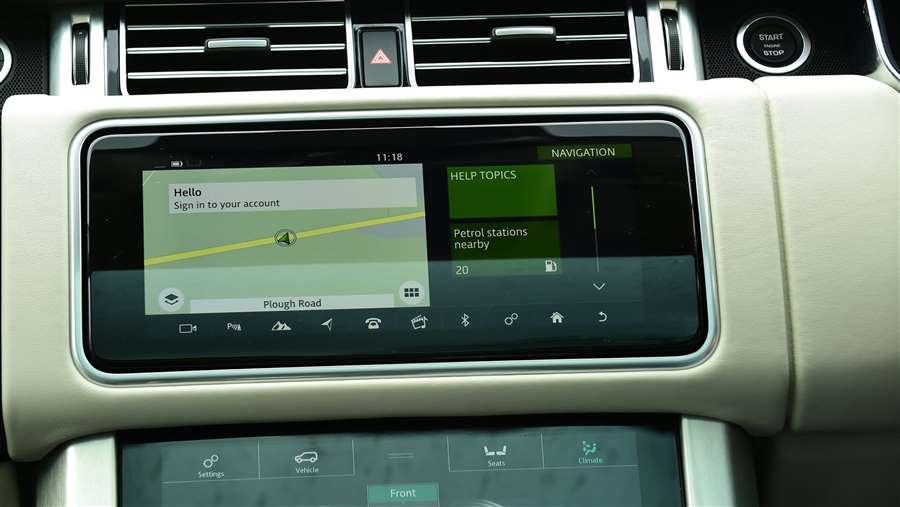
The ultimate high-performance Range Rover is the short-wheelbase SVAutobiography Dynamic, which can be identified by its unique finish to the side vents, bonnet and front grille, along with accents and badges on the bumper. Inside, passengers are treated to diamond-quilted leather with contrasting stitching and a special veneer finish to the dashboard.
Options
A key option is the Drive Pack, which includes a driver condition monitor to identify and warn of driver fatigue, blind-spot monitoring with reverse traffic detection and traffic-sign recognition incorporating a speed control system, which will automatically limit your speed according to the prevailing limit.
There's a huge amount of accessories on offer, but if you're a music fan there are a couple of special choices available, such as the 825-watt Meridian stereo with 19 speakers. True audiophiles can opt for a mind-blowing 1,700-watt, 29-speaker set-up.
Range Rover SUV - Practicality & boot space
There’s plenty of room in the Range Rover for a driver and four passengers, as well as loads of boot space
Anyone who's ever seen a Range Rover can tell you just how large it really is – at five metres long, there's not much on the road that’s bigger. That obviously means loads of space inside, but it's not much fun when it comes to negotiating narrow streets or squeezing into tight parking spaces. The long-wheelbase model is even bigger, so you’ll have to make sure you're not short on garage or driveway space.
Thanks to the Range Rover's considerable length, width and height, there's no shortage of space inside this large SUV. The big seats in the front are superb and there's enough room for the tallest or widest of occupants.
It's the same story in the back: few models provide this much space. But if that's still not enough, the long-wheelbase model increases rear legroom enormously.
Most models have space for five, but a four-seat option ditches the middle rear seat to create storage space and more room for the two remaining back-seat passengers. It feels wonderfully opulent, but choosing this option means you can't fold the rear seats down, although you can recline them.
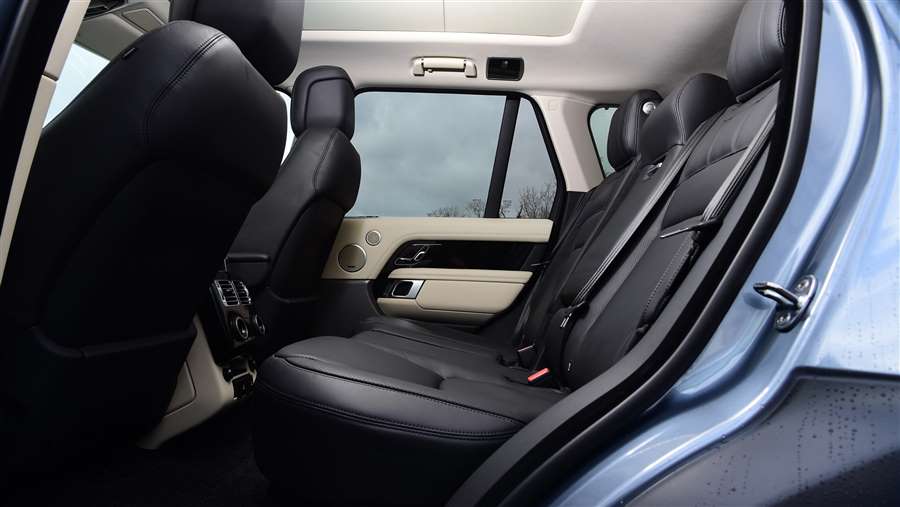
There's lots of storage space, too. The dashboard has two gloveboxes, there are big pockets in the doors and centre console and you can even specify a fridge between the front seats.
The bad news, though, is that the Range Rover feels huge. It can be difficult to get into it unless you use the 'access height' function, which temporarily drops the suspension by 50mm to let you climb in.
Once inside, you'll find the Range Rover's huge dimensions make driving it a bit tricky. It's a good job that you get large windows and big mirrors, and that you can see the bonnet edges from behind the wheel, because this all helps you to place the car on the road.
Land Rover offers plenty of gadgets to help make life easier for you, including a rear-view camera that comes as standard across the range. Then there's an automatic parking system to help with parallel and perpendicular parking, a system to alert you of traffic while you're reversing out of a space and a 360-degree camera, too.
If you want a bit more space in the rear, Land Rover also offers a long wheelbase version of the Range Rover for an extra £7,000.
First, the good news: the Range Rover has a massive 909-litre boot. If you need to put that into perspective, just consider that the practical Volkswagen Golf family hatchback has a 380-litre boot.
If you ever need more space than that, then you can just flip the rear seats forward to more than double the amount of storage up to 2,030 litres – as long as you haven’t gone for the two-rear-armchairs option.
All models get a powered split tailgate as well: you just press a button on the key to open the boot. The bottom half of the tailgate also folds out, giving you somewhere to sit while you take your muddy shoes off, or simply a way to slide big, heavy items into the boot. Recent revisions to the car included a hands-free boot opening feature.
Towing
It's a safe bet that a lot of Range Rover buyers will use their cars for towing – and it certainly boasts some impressive figures. The D300 diesel can tow an unbraked trailer, caravan or horsebox weighing up to 750kg and a maximum braked load of 3,500kg.
Those figures also apply to the D350 diesel, P400 and the V8 supercharged petrol models, while the P400e plug-in hybrid has a slightly reduced towing limit of 2,500kg. All Range Rovers have a maximum roof-rack load limit of 100kg, including the weight of the roof rails.
Range Rover SUV - Reliability & safety
Early cars had a few electrical gremlins, bu most of these seem to have been ironed out. The Range Rover also has excellent safety credentials.
Range Rover reliability
Land Rover has a reputation for making high-class, stylish 4x4s, but there's no denying its poor record for reliability over the years. The company has often finished towards the bottom of owner satisfaction surveys, with some big bills reported on older models.
The latest Range Rover is built in a different way and in a different factory to the previous car, while its electrical components are less complex and more reliable.
Too few Range Rover owners participated in our 2020 Driver Power satisfaction survey for it to be included. However, Land Rover finished 25th overall out of 30 brands covered in our 2020 survey, a disappointing fall from seventh place in 2018. The number of owners reporting a fault was 33.8%, the highest proportion of all the top 30 manufacturers.
Safety
The Range Rover has also been awarded a five-star Euro NCAP safety rating, which includes one of the highest ratings ever given for pedestrian protection in the large off-roader category.
Euro NCAP's tests praised the car for how it protects adult and child occupants. Its safety rating was boosted by a full suite of features, such as autonomous emergency braking and advanced traction-control systems that make the car safer and more stable on the road as well more capable off it. Should the worst happen, you and your passengers are protected by a full complement of airbags.
Source: carbuyer.co.uk
Ford Kuga SUV review
“The latest Ford Kuga is great to drive, good value and practical, so it should prove to be a very popular family SUV”
The Ford Kuga is a family SUV that’s an alternative to models such as the Volkswagen Tiguan, Skoda Karoq and Hyundai Tucson. Ford has two other SUVs, the EcoSport and the Puma, and the Kuga is larger than both of them - and costs more to buy.
If you’re looking for a medium-size SUV, there’s also the Toyota RAV4, the Peugeot 3008 and many more. Almost all the big car manufacturers offer a model like this, as they’re so popular. The Ford Kuga has its own appeal, though, which helps it to stand out.
Best family SUVs
The Kuga’s biggest strength, and the aspect that will appeal most, is the way it drives. The original Kuga was known for being the best car to drive of its type when it came out, and while this new model isn’t quite so far ahead of the competition, it’s still really enjoyable to spend time behind the wheel.
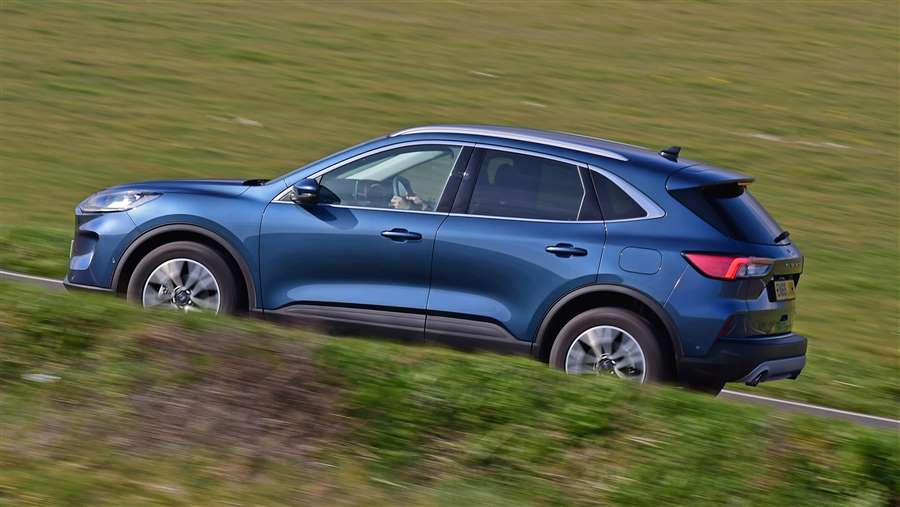
There are plenty of engines to pick from; there are two 1.5-litre petrol options, three diesels, a petrol-electric hybrid and a plug-in hybrid (PHEV) model with an official economy figure of over 200mpg. This version can drive for 35 miles on electricity alone, which is how it manages that incredible figure. One of the diesel engines (the 148bhp 2.0-litre model) also features mild-hybrid assistance to boost economy, though it can’t drive on battery power alone.
You’ll recognise the interior as Ford has carried over most of the parts from its other SUVs and hatchbacks. While it hasn’t got quite the same visual appeal as a Peugeot 3008 or Mazda CX-5, it’s logically laid out and the standard-fit eight-inch touchscreen controls a lot of the features. High-spec cars get a crisp 12.3-inch digital instrument cluster for the first time.
There are five trim levels to choose from, with the line-up kicking off at the Zetec model. Considering its entry-level position and low price, it’s rather well-equipped with sat nav, wireless phone charging, auto headlights and keyless start, plus a lot of standard safety kit.
Titanium adds LED lights, two-zone climate control and a premium speaker system, plus that 12.3-inch digital dial display. Then there are the sporty-looking ST-Line Edition and ST-Line X Edition pair, and the range-topping Vignale with unique styling touches and even more equipment.
A family SUV wouldn’t be much use if it wasn’t practical, but the Kuga impresses in this respect too. The rear seats slide fore and aft so you can prioritise legroom or boot space, and there are 526 litres to fill with the seats pushed forward. That compares well to the SEAT Ateca’s 510 litres and the 472 litres offered in the Renault Kadjar.
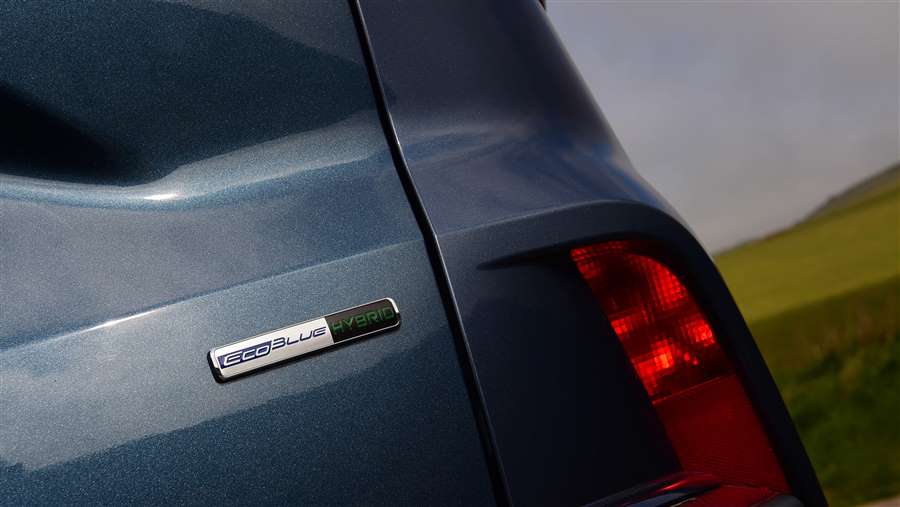
The Kuga has already gained a five-star Euro NCAP safety rating, which should be reassuring. However, Ford will hope the new Kuga improves the company’s position on our Driver Power survey; it came 24th out of 30 manufacturers in 2020.
Ford Kuga SUV - MPG, running costs & CO2
The Ford Kuga has economical engines and maintenance costs should be very competitive
Ford still has faith in diesel power, despite a fall in sales. In the Kuga there are three to choose from: a 118bhp 1.5-litre, a 148bhp 2.0-litre with mild-hybrid assistance and a 187bhp version of the 2.0-litre, which goes without the mild-hybrid tech. The mild-hybrid engine returns up to 57.6mpg and is expected to be popular with higher-mileage drivers, while the smaller diesel offers up to 60.1mpg with the manual gearbox (53.3mpg with the automatic) and the 187bhp engine can manage up to 49.6mpg. It’s the only model with four-wheel drive, so that figure isn’t too bad.
The two petrol engines both return between 42 and 43mpg, so won’t be too costly to run for low-mileage drivers. The normal hybrid model can return up to 51.4mpg. Provided you keep the battery topped up and drive mostly on electric power, the 2.5-litre PHEV model could offer the best economy; Ford says up to 201.8mpg is possible, but we’d recommend taking that with a pinch of salt. On longer journeys when the petrol engine will be the main power source, you’ll likely get an MPG figure in the mid-forties.
Perhaps more relevant is its claimed 35-mile electric range, as it will allow many commuters and families to complete their daily journeys without using a drop of fuel if the battery is fully charged. The PHEV will also appeal to business drivers, as its 32g/km CO2 emissions figure means a Benefit-in-Kind (BiK) tax rate of just 10% from April 2020. That compares to a 30% BiK rate for most petrols (the normal hybrid is 29%) and 30-32% for the front-wheel-drive diesels. VED costs £150 for petrol and diesel models, while the PHEV qualifies for a £10 annual discount.
Insurance groups
Insurance groups cover a relatively wide spread in the Kuga range but it shouldn’t be too expensive to insure.The entry-level petrol model sits in group 10, while the lower-powered diesel is in group 12. The range moves up to the most expensive PHEV model, which is in group 21.
For comparison, the Skoda Karoq starts in group 10 and the Peugeot 3008 spans groups 11-24.
Servicing
Ford has the largest dealer network in the UK, with a garage in most towns, and servicing doesn’t tend to be too expensive. Your dealer will be able to advise on service plans, which will cover a couple of services for an upfront fee or monthly payments.
Warranty
Like all new Ford cars, the Kuga features a three-year/ 60,000-mile warranty. That’s about average, but the Toyota RAV4 and Hyundai Tucson both have five-year warranties, and the Kia Sportage and MG HS offer an impressive seven years of cover.
Engines, drive & performance
It’s safe to say that previous Kugas have been a mixed bag to drive. The first-generation car was more fun than almost all of its rivals, but Ford tried to make the next one appeal to a wider audience, and it lost some of its sharpness as a result. We’re happy to report that the latest car is a return to form; it’s more agile than you might expect and doesn’t roll too much if you take a corner quickly.
The downside of that is a slightly firm ride. You’ll notice the imperfections in the road more than you would in a Volkswagen Tiguan, but we didn’t find it uncomfortable and most bumps were absorbed without any fuss. The car can start to feel fidgety at higher speeds but that’s mainly noticeable on rougher surfaces.
We found the steering light but it still has a lot more feel than plenty of other SUVs. The manual gearbox, standard in all but the 187bhp diesel and the plug-in hybrid, is precise and great to use.
Ford Kuga petrol engines
The two 1.5-litre EcoBoost petrol engines have been carried over from the old Kuga, but the entry-level 118bhp engine (only offered on Zetec models) is now almost a second quicker from 0-62mph. It still takes 11.6 seconds to hit that threshold, though, and we’d recommend going for the 148bhp version instead. It’s both more economical and quicker, hitting 0-62mph in a much more reasonable 9.7 seconds. Both these engines come with a six-speed manual gearbox and front-wheel drive.
Diesel engines
Also carried over from the old car is a 1.5-litre diesel engine, and it’s the only engine with a choice of manual or automatic gearboxes. Its 118bhp doesn’t feel quite enough to power such a big car, and 0-62mph takes 11.7 seconds for the manual or 12 seconds for the automatic. It’s around a second quicker than the same engine in the Mk2 Kuga, but still a bit pedestrian.
The diesel sweet spot is the 148bhp 2.0-litre engine, which now comes with mild-hybrid technology - improving fuel efficiency and giving the engine welcome extra grunt. It’s the most efficient diesel and its 9.6-second 0-62mph should be sufficient for the majority of buyers. Above that, there’s a 187bhp 2.0-litre engine without the mild-hybrid assistance, which reduces the acceleration time to 8.7 seconds. At present, this only comes with four-wheel drive and an automatic gearbox.
Hybrid engines
The Kuga is available as a normal hybrid (Ford labels it as FHEV) and as a plug-in hybrid (PHEV). Both use a 2.5-litre petrol engine, an electric motor and a battery. The normal hybrid uses engine power to charge the battery, whereas the PHEV can be plugged in, either at home or at a public charger.
In both models, the Kuga will move off in near-silence thanks to the electric motor. Power is instant and delivered smoothly.
Both cars use a CVT gearbox. This is different to a normal automatic as there aren’t any individual gears as such, so when you put your foot down it tends to bring revs up, causing an unpleasant droning noise.
Interior & comfort
Ergonomic if a little unimaginative, the Ford Kuga’s interior shares much with other Fords
The last Kuga was generally quite refined but was a little noisy on the motorway. From our drives so far, it seems that its replacement is better in this regard. The 2.0-litre diesel with mild-hybrid tech sounded a little vocal under hard acceleration but it settles down when cruising.
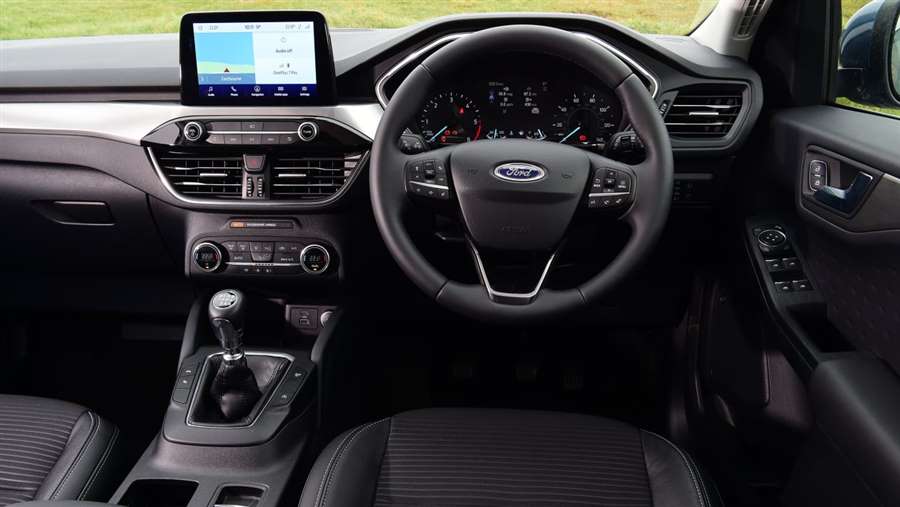
We found that the bases of the sports seats fitted to our Titanium-spec test car were a little flat for our liking, making them uncomfortable on longer drives. Otherwise, the Kuga features plenty of equipment to take the stress out of the daily commute; lane-keeping assistance, all-round parking sensors, cruise control and hill-start assist all come as standard.
Ford Kuga dashboard
Ford has decided to keep things simple, giving the Kuga the same interior as the Fiesta, Focus and other models. A Peugeot 3008 certainly has more design flair inside, but the Kuga’s interior is simple and intuitive, whether you’re familiar with Ford interiors or not. Besides, the cabin design is a marked improvement over the old Kuga, which was really showing its age having been around since 2012.
An eight-inch touchscreen sits on top of the dashboard, plus a 12.3-inch digital dial display on Titanium models and above. Beneath that is a panel for audio controls, the air vents and the heating controls, with a few extra buttons each side of the gearlever.
The material quality is good in the places where you’ll touch, but there are cheaper, scratchier materials lower down. It all feels well-built, though, so it should stand up to years of family life.
Ford’s SYNC 3 infotainment system is fitted as standard and provides plenty of connectivity. It includes both Apple CarPlay and Android Auto, allowing your phone’s apps to be displayed on the screen, plus DAB radio and Bluetooth. Voice control is also part of the package, so you can access the screen’s functions without taking your hands off the wheel or eyes off the road.
Equipment
Buyers have a choice of five trim levels. Zetec is the entry point, and includes luxuries like keyless start, auto lights and wireless phone charging. It also gets sat nav, cruise control and a handy heated windscreen, but you need to step up to Titanium in order to get dual-zone climate control and auto wipers. Titanium also brings LED headlights, keyless entry, a 12.3-inch digital dial display and a premium B&O sound system, too.
ST-Line gets sporty detailing inside and out, plus sports seats and cornering LED fog lights. ST-Line X models can be distinguished by larger alloy wheels and a panoramic sunroof. There’s also heated seats in the front and rear.
The top-spec Vignale model aims to look elegant rather than sporty, and has lots of equipment to offset its high price. You get metallic paint as standard, along with a different grille, leather upholstery and a full set of heated seats.
Options
Once you’ve picked your trim, you can then select from a number of options including a Technology Pack (upgraded headlights and a head-up display - £400), a winter pack (heated front seats and a heated steering wheel - £400) or a tow bar for £625. We’d recommend spending £100 on a space-saver spare wheel instead of the standard-fit tyre repair kit.
Practicality & boot space
The Ford Kuga can compete with the class leaders on practicality
The latest Ford Kuga is bigger in most respects than its predecessor, with a little more space freed up inside. It’s still strictly a five-seater, like many of its rivals, but Ford doesn’t offer a seven-seat SUV in the UK - just the S-MAX, Galaxy and Grand Tourneo Connect MPVs. This seems like a missed opportunity, as the seven-seat Skoda Kodiaq, Peugeot 5008 and Nissan X-Trail SUVs have all proven popular.
Ford Kuga interior space and storage
We expect that the Kuga will be bought by people who have outgrown the Focus or other cars of that size, and it’s usefully more spacious. Adults will have more than enough space to stretch out in the rear seats, and should be comfortable on long journeys.
The glovebox and door pockets are a good size, and there are a couple of other little cubbies and storage areas on the centre console. All cars get an electrical charging point in the back of the front armrest, which will keep your passengers’ phones or tablets powered.
Boot space
The Kuga has handy sliding rear seats, so you can position them to prioritise legroom or boot space. Even when slid all the way back, most Kuga models offer 475 litres of space - 100 litres more than the Focus - and this increases to 526 litres with the seats pulled forward (measured to the parcel shelf). With the rear seats flipped down and out of the way, you’ve got up to 1,534 litres to fill. A Skoda Karoq is slightly more practical, offering 479-588 litres with the seats up and 1,605 litres with them down, but the difference is unlikely to make you rule out the Kuga.
Because of where the battery pack’s placed, the plug-in hybrid models get a slightly smaller boot. Wherever the seats are, the boot is about 50-60 litres smaller than petrol and diesel variants. Compared to some other PHEVs, that’s not a huge drop in luggage capacity.
Towing
If you plan on towing regularly, make sure you pick the right engine, as all have different maximum towing capacities. The 118bhp diesel can tow a braked trailer weighing up to 1,500kg, increasing to 1,600kg (118bhp petrol), 1,800kg (148bhp petrol), 1,900kg (148bhp diesel) and 2,100kg (187bhp diesel). Not all PHEVs can tow, but the Kuga plug-in can manage up to 1,200kg. Speccing a tow bar costs £625.
Reliability & safety
The Ford Kuga has a full five-star safety score but reliability is unknown
Ford Kuga reliability
The Ford Kuga is too new to feature in our 2020 Driver Power owner satisfaction survey, but the previous model scored quite well; it placed 44th out of the top 100 cars ranked, and only 8.5% of buyers told us about a fault in the first year of ownership. However, Ford came a meagre 24th out of 30 brands in our manufacturer list. With the new Focus, Puma and Kuga now all on sale, we expect Ford to climb up the rankings in the next couple of years.
Safety
Independent testers Euro NCAP put the Kuga through its paces before it even went on sale, and it passed with flying colours. Receiving a five-star score, the Kuga scored 92% for adult safety, 86% for child safety, 82% for pedestrian protection and 73% for the array of safety kit on board.
Standard safety features include lane-keeping assist, hill-start assist, auto emergency braking and intelligent speed assist. A Driver Assistance pack costs £1,000 and adds kit such as blind-spot monitoring, traffic sign recognition and front and rear cameras.
Source: carbuyer.co.uk
BMW iX3 SUV review
"The BMW iX3 is an electric variant of the popular X3 with a 285-mile range"
While BMW wowed the world with its i3 electric hatchback and i8 plug-in hybrid coupe, the all-electric BMW iX3 SUV is altogether a more staid proposition. This time round BMW is taking a similar approach to Peugeot and Hyundai by serving up an electric version of a car it already sells, namely the BMW X3.
There's been a deliberate decision not to go radical with the design, with BMW instead opting to add aerodynamic wheels, blue trim accents and a smoothed-off grille. There are also a new set of bumpers and side skirts, all tested to ensure they are slippery enough to help maximise the driving range. This is really just an X3 for buyers who want an electric powertrain.
Best electric SUVs
Under the car's floor is an 80kWh battery that sends its power to a rear-mounted 282bhp electric motor. This is a departure from rivals like the Audi e-tron, Jaguar I-Pace and Mercedes EQC, which all have two motors, four wheel drive and quite a bit more power. While it isn't as fast as them, the iX3's 285-mile range is competitive, beating both its German rivals and just slightly behind the I-Pace. The Jag’ struggles to hit its official figure in real-world driving anyway.
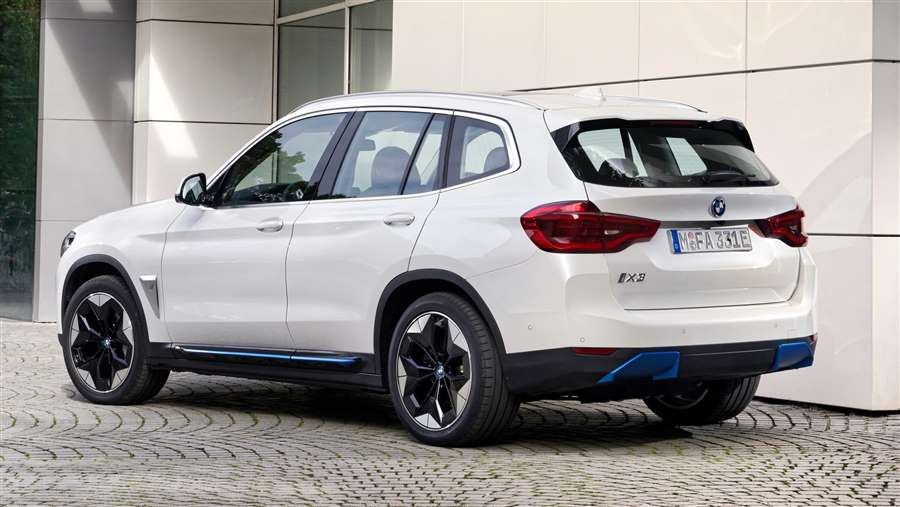
It can also be charged quickly, obtaining speeds of up to 150kW at the latest rapid-charging stations. Of its closest rivals, only the e-tron can match this, with the others topping out at around 100kW, and it means the iX3 battery can be replenished to 80% in a speedy 34 minutes. Thanks to this capability, making one stop on a long journey should be ample to get drivers to their destination with range to spare.
Like the exterior, the inside of the iX3 is very much a mild variation on the X3, with some flashes of blue trim to show this is the electric version. It shares the same 10.25-inch iDrive infotainment display perched above the dashboard and a 12.3-inch digital instrument screen. Premier Edition and Premier Edition Pro trims serve up plenty of equipment, with features like a head-up display, a Harman Kardon stereo and wireless phone charging in the top trim.
The BMW iX3 is spacious, quiet and has a good range, but it's a shame it doesn't feel anywhere near as special as the i3 and i8. Instead, it ushers in an era when electric BMWs will be a more mass-market part of the line-up.
By adding an EV option to its popular X3 range, BMW boasts that customers can now choose between four different powertrains for its mid-size SUV. It adds to the existing petrol, diesel and plug-in hybrid range, giving low to medium-mileage drivers the chance to shun traditional fossil fuels altogether.
BMW iX3 MPG & CO2
The iX3 has an 80kWh battery beneath its floor, allowing it to cover up to 285 miles on a charge. That's competitive with the 298-mile range of the Jaguar I-Pace, and betters the 237 and 256-mile range of the Audi e-tron and Mercedes EQC respectively.
Like the e-tron, the iX3 also supports rapid 150kW charging at compatible public locations, topping the battery up to 80% in just 34 minutes. The Mercedes and Jaguar can be topped up at around 100kW, so take longer to recharge.
As with any electric vehicle, the iX3 has the potential to significantly reduce running costs for the owner, and we particularly enjoyed one new feature for its energy recuperation system. Like most new EVs, the braking effect of the electric motor can be set to low, medium or high, and with practice it's possible to drive the iX3 in traffic with almost no use of the brakes. However, BMW has also added an ‘Adaptive’ setting, which automatically adjusts the recuperation to match the car ahead, a bit like adaptive cruise control for braking alone. It works well, carefully adjusting the regenerative effect to match cars in front, even when they modulate their deceleration.
Thanks to its zero emissions, the iX3 qualifies for free car tax and 0% BiK for company-car drivers in 2020/21.
Insurance groups
The insurance band for the iX3 hasn't been announced yet but it's likely to be fairly high. We say this because its rivals are all costly to insure, with the I-Pace in group 49 out of 50 and the Audi e-tron in the very top group. However, the iX3 is the least powerful of the group, so could be a few groups lower.
Warranty
BMW sells all its cars with a three-year/unlimited mileage warranty, which is on a par with Mercedes and slightly more generous than Audi (with a 60,000-mile cap). Tesla models come with a four-year or 50,000-mile warranty. It's likely the BMW iX3 will have a longer warranty covering its battery (many rivals offer eight years of cover), but details of this have yet to be announced.
Servicing
BMW models are fitted with an array of sensors to determine when servicing is required, so there isn't a strict routine to stick to. Typically, services won't be more than two years or 20,000 miles apart, and isn't the cheapest. BMW does offer servicing packages though, making it possible to spread the cost over monthly payments.
Unlike its rivals, the iX3 gets a single electric motor powering the rear wheels. This means it isn't as quick as the dual-motor Jaguar I-Pace in a straight line, but it still gets a sporty setup in typical BMW fashion.
In fact, it would have been better if BMW had made the suspension softer because in its pursuit of agile, fun handling, ride comfort has been compromised. Even in the softest Comfort mode, the iX3 fidgets and seems to find bumps in the road that look inconsequential from behind the wheel.
This chassis setup and the low-slung battery does at least mean the iX3 corners with little body lean, while the steering is fast to respond, if lacking in feel. Sport mode makes the steering heavier but also renders the suspension too bouncy, so we quickly turned it off.
BMW iX3 electric motor
The iX3 is powered by a single 282bhp electric motor at the rear axle, giving it a 0-62mph acceleration time of 6.8 seconds. This should be plenty quick enough for most SUV (and EV) buyers, but it's some way off rivals. The Audi e-tron, Jaguar I-Pace and Mercedes EQC all feature front and rear motors, providing more power and four-wheel drive.
The iX3 accelerates very quietly, with just a distant whine from its electric motor. If you prefer, you can also choose a louder sound thanks to 'balanced' and 'sporty' settings. The iX3 glides away from a standstill smoothly, with instant pulling power doing a good job of disguising its 2,185kg weight.
Interior & comfort
Unlike the daring BMW i3 and i8 models that set out BMW's stall as a designer of forward-thinking green models, the iX3 is a much more conventional model that's also available with electric propulsion. This will make sense for many customers, while others may view it as a bit of a disappointment.
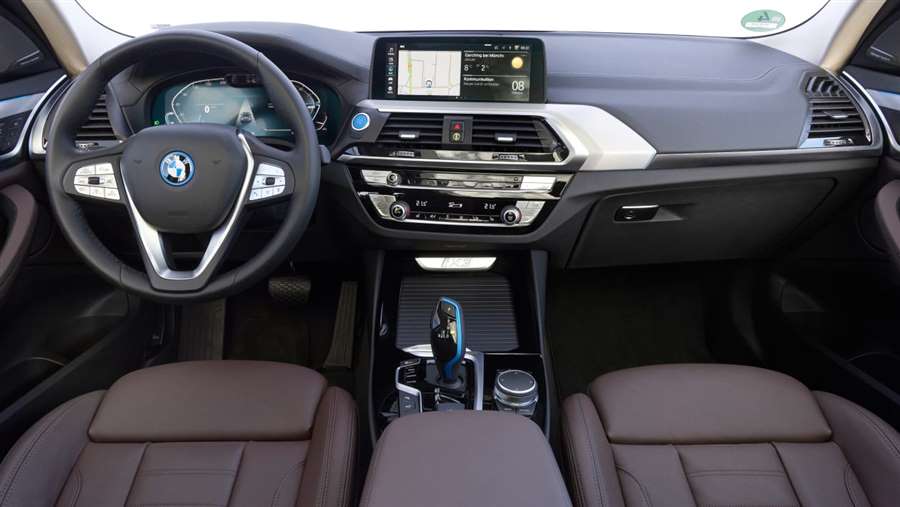
If you've sat in a BMW X3, there's very little change here apart from some blue flashes of colour for the BMW badge and gearlever. The steering wheel with silver buttons is new, while a 10.25-inch infotainment display and 12.3-inch digital instrument cluster is carried over, with Apple CarPlay and Android Auto.
Materials are of a high quality and the infotainment software is amongst the best in the business, but there aren't any novel features like trim made from recycled bottles or cork, as seen in many environmentally conscious models.
Equipment
The first versions of iX3 will be called Premier Edition and Premier Edition Pro, with four exterior colours offered, along with two choices of exterior trim colour: aluminium or gloss black. Standard kit includes wireless smartphone charging, heated front seats and Driving Assistant Professional.
Premier Edition Pro is distinguished by large 20-inch aerodynamic alloy wheels, along with a powered tailgate, adaptive suspension and a panoramic sunroof. It also boasts a plethora of tech like a head-up display, Harmon Kardon stereo, gesture recognition and a BMW IconicSounds Electric soundtrack developed with famous composer Hans Zimmer.
If there are concerns the iX3 is compromised compared with the regular model, fear not. It's virtually as usable for a family of five as the petrol or diesel car, and the boot is actually larger than the one in the plug-in hybrid BMW X3.
BMW X3 interior space & storage
There's plenty of space for adults in the front and back of the iX3 to stretch out, with the battery placed out of the way beneath the car's floor. In reality, most won't need the extra space found in the larger BMW X5 but there's no option of a third row of seats to make the iX3 into a seven seater.
Boot space
The iX3 has a 510-litre boot, which is 40 litres smaller than the petrol and diesel BMW X3 offer. In reality, most will be hard pressed to tell the difference, and surprisingly this is 60 litres more than the plug-in hybrid version of the X3 offers. The electric motor and transmission featured here is actually more compact than in the PHEV, so takes up less space.
Source: carbuyer.co.uk
Toyota Corolla Trek
"Go anywhere looks for faux off-road Corolla wagon"
Take the recently introduced Corolla Touring Sports estate, elevate the ride height, add some cladding to the bodywork and the result is this – the Toyota Corolla Trek.
Those of you with longer memories will recall the Toyota Tercel – a rugged-yet-compact four-wheel drive estate from the mid-1980s. This is not quite the same thing remixed for a modern audience, primarily because the Corolla Trek is front-wheel drive only, with no sign of a 4x4 model on the horizon.
In an admittedly small market sector where two of its key rivals – the Skoda Octavia Scout and Volkswagen’s Golf Alltrack – are available with four-wheel drive, that may be a limiting factor, but closer in spirit to the Toyota is the Ford Focus Active Estate, also an exclusively front-wheel drive model.
Unlike the Ford, there’s no Trek based on the Corolla hatchback body, but that would be a relatively straightforward addition if the market demand is there.
Will the Toyota Corolla Trek be good off-road?
It doesn’t look like it. While it does appear to be aimed at those with more adventurous lifestyles, it won’t be able to compete with more focused SUVs, such as Toyota’s own RAV4 and Land Cruiser.
Toyota Corolla Trek rear three-quarter
The Trek name comes from the bicycle brand Toyota has partnered with, a move which clearly highlights their intended market for this variant – keen mountain adventurers should take note. Compared with the regular Corolla Touring Sports estate, the Trek enjoys a 20mm increase in ride height, which isn’t going to take you very far off road, so a bike mounted on the roof would prove useful.
Toyota Corolla Trek: limited changes for an SUV look
Clearly the Corolla Trek is not a crossover, but a halfway house between a regular estate and an SUV, so visual changes from the Touring Sports are limited.
Outside, stylistic changes are restricted to chunkier bumpers complete with skid plates front and rear to lend an air of off-roading authenticity.
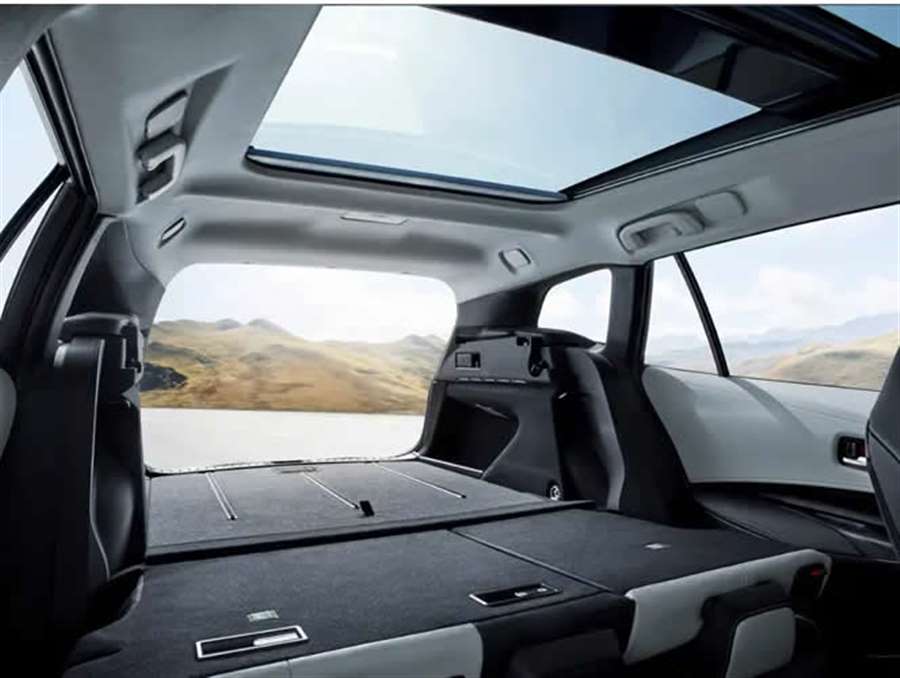
We’ve yet to see images of the interior, but Toyota’s referenced two-tone seat trim and wooden decorative panels. Whether this ‘wood’ is actually related to anything that was once a tree remains to be seen.
Toyota Corolla Trek: exclusively hybrid power
Cars with genuine off-road capability have long been most popular with diesel engines, but as Toyota’s ditching these kind of motors for its mainstream models, the Corolla Trek will be petrol-electric hybrid-only.
However, there’s a choice of two powerplants seen in the regular Corolla models: a 122hp 1.8-litre, which lacks low-range torque, but a much more powerful 180hp 2.0-litre should provide a considerably more pulling power when required.
Precise performance, economy and emissions figures will be released in due course
Source: parkers.co.uk
2021 Nissan Rogue Review: More Steps Forward Than Backward
The verdict: The redesigned 2021 Nissan Rogue adds much-needed driving refinement, though it comes with a bothersome side of ride firmness.
Versus the competition: Return shoppers will miss the outgoing Rogue’s soft ride, but firm suspension tuning never stopped a compact SUV from selling like gangbusters. Other aspects run the gamut, and our overall impression is two steps forward, one step back.
Redesigned for 2021 with running lights spaced high above the headlights — a look popularized by the old Juke and, now, a smattering of Hyundai models — the Nissan Rogue comes in four trim levels: S, SV, SL and Platinum. Each offers front- or all-wheel drive; compare the trims here or stack up the 2021 and 2020 Rogue here. Don’t confuse it with the Rogue Sport, a smaller model based on a separate platform. All trim levels pair a 2.5-liter four-cylinder engine with a continuously variable automatic transmission. We evaluated a Rogue SV AWD.
Improved Road Manners, Mostly
Competitors steadily surpassed the outgoing (2014-20) Rogue in the all-important battleground of ride and handling. When we compared Nissan’s compact SUV against the field in late 2017, it ranked mid-pack in ride quality and last, by a mile, in handling. The redesigned Rogue makes significant strides on the latter front, with a quick enough steering ratio for precise directional adjustments as you negotiate sweeping on-ramps. Nissan dialed back much of the prior generation’s nose-heaviness and numb steering, too. Steering and dynamics aren’t exactly towering strengths for the new Rogue, but they’re far from liabilities.
Unfortunately, that comes at a cost: The suspension introduces a degree of impact harshness over potholes and sewer covers that the outgoing Rogue dispatched with minimal complaint. Nissan says suspension tuning is the same across all trim levels, and our SV test car had 18-inch wheels (S trims have 17s, but the SL and Platinum have 19s, which may ride harsher still). Overall isolation and body control are fine, but the shock firmness is puzzling, given the Rogue’s comfort-oriented history. Perhaps Nissan benchmarked the current-generation Honda CR-V and Toyota RAV4, two popular but firm-riding rivals. In any case, the pendulum has swung both ways at Nissan: The recent Sentra redesign stays fittingly soft, while the current-generation Altima skews firm.
The 2021 Rogue gets the same 2.5-liter four-cylinder engine from that Altima (here it makes 181 horsepower and 181 pounds-feet of torque), rejiggered from an earlier 2.5-liter that preceded it. Paired with a CVT that raises revs fast enough from a standing start, the 2.5-liter provides enough power around town but needs most of its reserves to reach highway speed, especially with multiple occupants aboard. If you need more power while already in motion, the CVT again increases engine rpm quickly enough. It’s slightly quicker in a driver-selectable Sport mode, but that setting keeps revs awkwardly high all the time — not simply hastening the transition, as effective Sport modes often do.
The Interior: Quality and Utility
Rife with all the trending elements in today’s automotive interiors, the Rogue’s cabin features a floating touchscreen, electronic gear selector and high center console, plus lots of stitched dash and door surfaces. Quality mostly lives up, with generous padding where your arms rest and a sturdy grade of fabric upholstery in our test car. Cost-cutting becomes evident once you get to the backseat — the norm in this class, though a few rivals improve on it. Leatherette (vinyl) and leather are both optional, and upper trims pad where your knees meet the console. That’s a useful provision, as its bulky design inhibits some lateral space. Nissan’s spring-loaded electronic gear selector feels a bit rickety to operate, but it’s a rare blemish among otherwise high-quality controls.
Interior storage is in good supply. With no mechanical linkage to select gears, the center console has a medium tray underneath, plus multiple cubbies around the cupholders. Gone is the outgoing Rogue’s deep glove compartment, but the other nooks more than make up for it. Unfortunately, utility behind the front seats takes, well, a slight backseat. The rear seats lose the outgoing Rogue’s 40/20/40-split, reclining functionality and sliding adjustment, the latter of which allowed owners to maximize cargo or passenger space; now the seat just reclines in a traditional 60/40 split. Legroom is fine, but the bench sits a bit closer to the floor than before, such that some adults may find their knees uncomfortably elevated.

We measured 17.1 cubic feet of cargo volume behind the backseat in our Rogue SV, and that’s with a fixed cargo floor. SL and Platinum grades get Nissan’s Divide-N-Hide cargo system, which has a dual-level load floor that should add slight volume. In any case, the SV’s room lands within fighting range of others (we measured 18.7 cubic feet in a Toyota RAV4 Prime, for example). Note that it comes by way of our independent accounting of cargo space, a practice we’ve instituted amid inconsistent methodology from manufacturer-reported volumes.
Technology and Safety
The Rogue’s standard 8-inch touchscreen has Apple CarPlay and Android Auto, both via tethered connections, and two USB ports. Tech options include two additional backseat USB ports and an upsized (9-inch) touchscreen with wireless CarPlay, plus 12-inch virtual gauges, wireless smartphone charging and a Bose premium stereo. (Android Auto is strictly a tethered connection; no wireless connectivity is available.)
As of this writing, third-party crash tests have yet to be published for the 2021 Rogue. Standard safety features include automatic emergency braking with pedestrian detection as well as blind spot and lane departure warning systems. Nissan’s ProPilot Assist system, included on the SV grades and up, incorporates adaptive cruise control with hands-on lane-centering steering, both of which work from a stop all the way up to highway speeds. Note that this isn’t the automaker’s second-generation ProPilot Assist with hands-free lane centering, which debuted on the new Ariya SUV.
Features and Pricing
Including destination, the 2021 Rogue starts just under $27,000. That’s a stone’s throw from its predecessor, and in the thick of its rivals’ starting prices. Characteristic of the class, it’s well equipped on the safety and multimedia fronts but basic beyond that: Rogue S shoppers can expect manual seats, cloth upholstery, manual climate control and basic keyless entry.
Climb the trim levels, and you can get a panoramic moonroof, hands-free power liftgate, vinyl or leather seats, keyless access, power front seats (though without a passenger height adjustment), tri-zone climate control and heated seats in both rows. A loaded Rogue Platinum AWD tops out in the high $30,000s, which is also competitive.
Naturally, the Rogue’s improved agility is a modest adjustment to what it once was; this is no sports car masquerading as an SUV. The improvements come at some expense to comfort, and the utility setup takes half a step backward. But the SUV takes more steps forward, and it doesn’t come with a huge jump in price. In balance, it’s a notably better SUV than the one it replaces — something shoppers who don’t prioritize comfort or utility can appreciate.
Source: cars.com
Lexus UX SUV review
"The economical Lexus UX looks and feels great, but falls short on versatility"
The premium compact SUV class is growing rapidly at the moment. Buyers can't get enough of fashionable crossovers such as the BMW X2 and Audi Q2. 'Hybrid' has become something of a buzzword, too, so a hybrid premium compact SUV really ought to be a sales sensation.
This is what Lexus, the upmarket arm of Toyota, hopes for its all-new UX 250h. It's the smallest SUV the company has yet offered, slotting beneath the Lexus NX in the brand's line-up and offering an alternative to its other hybrid model, the more conventionally styled Lexus CT hatchback. It'll also compete against the Jaguar E-Pace and Volvo XC40, while potentially persuading would-be Toyota C-HR buyers to push a little further upmarket.
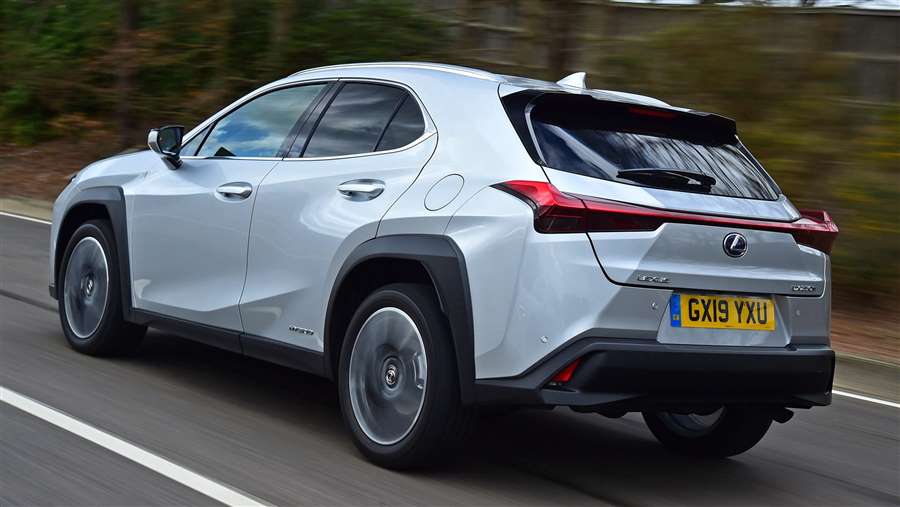
It comes as no surprise that Lexus should opt for hybrid power in its smallest SUV – the larger Lexus RX was something of a pioneer, offering hybrid power since 2004. The technology has since made big leaps forward in fuel-efficiency, though, and Lexus claims some fairly startling economy figures for the smaller, lighter UX. Modest CO2 emissions figures should make the UX an attractive proposition for company-car users, too.
Externally, the Lexus UX wears the brand's trademark 'spindle' grille, but isn't quite as bold and outspoken as the larger Lexus NX. The overall shape has the sleek silhouette of the latest coupe-SUVs, and despite its tough-looking black wheelarch mouldings, the stance is more soft-roader than go-anywhere vehicle.
That streamlined shape is reflected inside, where interior headroom is more saloon than SUV and the driving position is only a little higher than a typical family hatchback. Boot space is rather meagre, too, so this might be a crossover more suitable for couples than larger parties.
Although some may miss the lofty perch that other SUVs can provide, many will enjoy the UX's sporty driving position; there's no doubt it contributes to the driving experience, which feels a little more involving than some rivals. It just goes to show how capable Toyota's TNGA platform – also found under the Toyota Prius hybrid and latest Toyota Corolla – really is. Four-wheel drive is also offered in the UX 250h hybrid, badged E-Four, but we wouldn't recommend this version unless you really need extra traction in winter, because it makes the car less efficient.
Touted as a cutting-edge product at launch, the UX ticks all the usual safety boxes with autonomous emergency braking, lane-departure warning, traffic-sign recognition and automatic headlights. There's a radar cruise-control system, too, with a mode for use in stop-start traffic at up to 18mph.
Lexus proudly occupies the number-one slot in our 2020 Driver Power owner satisfaction survey, even though the brand's three-year/60,000-mile warranty is less generous than Toyota's.
If you'd rather a longer warranty, the Toyota C-HR hybrid remains a less expensive – and slightly more spacious – alternative to the Lexus UX, but many will find the latter's extra style and interior appeal worth the extra outlay. High-mileage private buyers may find conventional diesel-powered rivals, such as the BMW X1 sDrive18d, will be cheaper to run, too.
Lexus UX MPG & CO2
The Lexus UX 250h uses the very latest hybrid technology that Toyota has to offer, having much in common with the latest Toyota Prius. Official WLTP figures span from 50.4 to 53.2mpg for the standard UX and 47mpg for the four-wheel drive version. We managed 50mpg in a test car, despite the big 18-inch alloy wheels included with the F-Sport trim level.
Stick with two-wheel drive and the Lexus UX emits from 120g/km of CO2 with 17-inch wheels fitted and 126g/km with 18-inch alloys. Benefit-in-Kind (BiK) liability for company-car drivers spans from 27 to 28%. Emitting around 135g/km, the four-wheel drive UX sits in a higher BiK band with either size wheels.
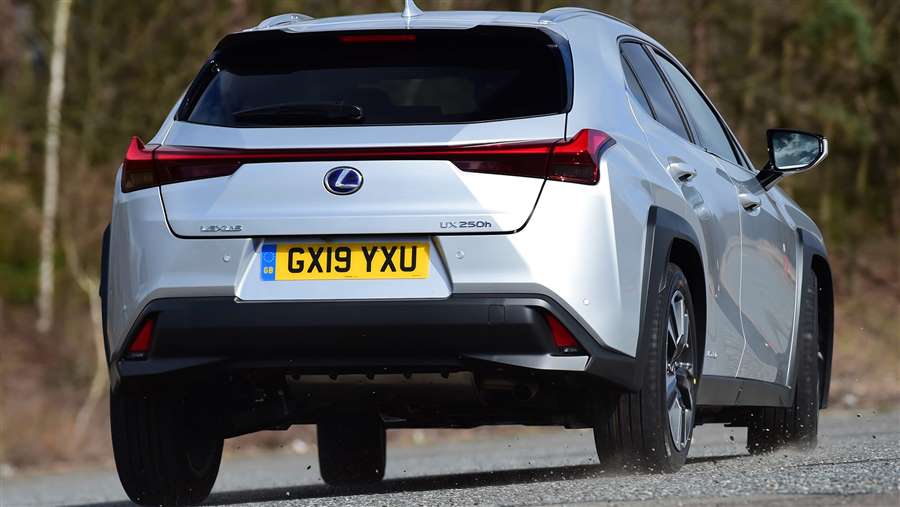
Insurance
The Association of British Insurers has placed the Lexus UX in insurance groups 22 to 26 out of 50, making the Lexus a little more expensive to insure than the cheaper but mechanically related Toyota C-HR hybrid, which occupies insurance group 14 in top-spec Excel form. Meanwhile, the most economical Mercedes GLA is in insurance group 21, while the BMW X1 starts in insurance group 26.
Servicing
Lexus offers fixed-price servicing for all models. Although pricing for the UX has yet to be announced, service schedules are sure to match the pattern of other hybrid models in the range, with a major service every 20,000 miles and an intermediate oil-change service every 10,000 miles.
Warranty
Lexus' three-year/60,000 mile warranty closely matches that provided by Volkswagen and Audi, but falls behind the three-year/unlimited-mileage warranties of Mercedes and BMW. It also lags behind that provided by Toyota, which lasts for five years or 100,000 miles. Lexus can provide an extended warranty, though, keeping you covered once your original policy's age or mileage limit is breached. It's also worth noting that the hybrid powertrain comes with a five-year/60,000 mile warranty for extra peace of mind.
The Lexus UX 250h uses a platform known as Toyota New Generation Architecture (TNGA), which underpins a range of cars as diverse as the Toyota Prius, Toyota Corolla and Toyota C-HR. That fact might not scream 'sporty', but prospective Lexus UX purchasers are in for a pleasant surprise.
Sitting in a driving position somewhat lower than that of most compact SUVs, you're well placed to get the most out of how the Lexus handles. That's no empty gesture, either, because the UX really does offer enough driving involvement to be a pleasure to drive. The steering is accurate and has a pleasingly weighty feel, while strong grip helps confidence in sharp corners.
Lexus claims to have gone to some lengths to make the UX feel good to drive, taking the trouble to mount the steering rack directly to the chassis in an effort to reduce flex and vibration, and these efforts have definitely paid off; the UX is more fun to drive than the Audi Q2 and runs the BMW X2 close. What's more, the car's impressive resistance to lean in corners doesn't come at the expense of a hard ride, at least not with the optional adaptive damping system fitted. We've yet to evaluate how the standard suspension deals with road imperfections.
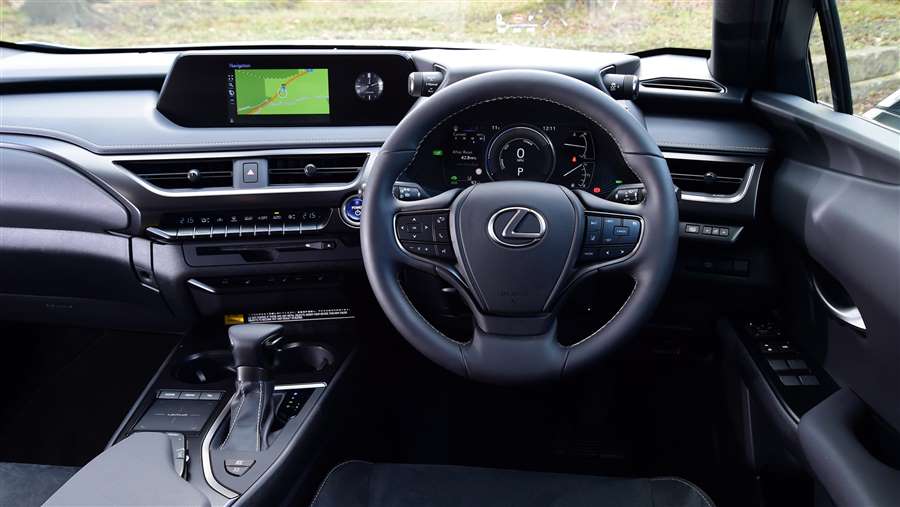
The UX is available with either front-wheel drive or 'E-Four' all-wheel drive, but the latter is intended more to maximise traction on poor roads and in adverse weather conditions than to bestow the UX with real all-terrain ability. For most buyers, we'd recommend saving the £1,200 or putting it towards a set of winter tyres for the front-wheel drive version.
Lexus UX hybrid engine
Only one engine is offered for the Lexus UX – the 250h. It's billed as a 'self-charging' hybrid, but that tag is little more than a positive spin on the fact that it has no plug-in facility. As a result, the UX can only move under all-electric power at moderate speeds, but it does bring a welcome degree of quietness in urban traffic.
The four-cylinder 2.0-litre petrol engine produces 144bhp and twin electric motors contribute 108bhp, making 0-62mph possible in 8.5 seconds. It feels quicker off the mark than the Audi Q2 fitted with a 1.5-litre turbo and driving is effortless thanks to a CVT automatic gearbox that proves smooth and seamless in operation. Unusually, the paddles either side of the steering wheel aren't for changing gear, but for setting the rate of regenerative braking. This system uses energy released during deceleration to help charge the UX's hybrid battery.
The E-Four four-wheel drive version gets an extra motor for the rear wheels, providing up to 7bhp and 55Nm of pulling power but also adding 60kg of weight. In most driving situations it feels identical to the front-wheel drive version, with enough electric assistance to prevent the petrol engine from feeling overworked. However, with less weight, the standard UX can run in EV mode more often, so unless you park on a slippery field or track every day, the benefits are marginal.
Interior & comfort
The Lexus UX looks and feels great inside
The Lexus UX is generally smooth and relaxing to travel in. At higher cruising speeds, its slippery shape helps to keep wind noise at bay, and occupants will find tyre noise far more intrusive than any other mechanical sound. The clever (optional) active damping system is effective at ironing out road bumps, but we've yet to try the standard suspension.
Lexus has established an enviable reputation for interior design and quality, and the UX doesn't disappoint. The materials used are from the top drawer, and the layout is distinctive and pleasing to look at. Enthusiasts might even spot a few visual influences from the range-topping Lexus LC sports coupe.
Lexus UX dashboard
The UX's dashboard sweeps around the driver, who's placed right in the centre of the action. The instrument cluster is a little smaller than that of some rivals, but its seven-inch digital display is clear and easy to understand and can be configured to your taste.
Lexus UX interior19
Major features, such as the climate-control system, are easy to use thanks to piano-style buttons in the centre console. However, we remain unconvinced by the touchpad system that Lexus employs for its infotainment systems. It's fiddly to use when at a standstill, and worse when you're on the move. There's no Apple CarPlay or Android Auto on board, either, but the wide central touchscreen looks great.
Equipment
The UX is available in three trim levels. The entry-level model is simply the UX, followed by F Sport and top-spec Takumi.
The UX comes with sat nav, dual-zone air-conditioning and 17-inch alloy wheels, along with compatibility with Android Auto and Apple CarPlay. The F Sport has sporty styling extras to give it a more muscular appearance, as well as 18-inch alloy wheels, sports seats, pedals and steering wheel. The trim level also includes heating for the seats and steering wheel, plus tinted rear windows. There's also the option of Active Sound Control (ASC), which "generates the aural effect of up and downshifts like those of a geared automatic transmission". In common with other cars that offer a digitally synthesised engine noise to increase aural stimulation, the F-Sport is available with Sonic Interaction Design (SID). It allows you to tailor the 'engine sound' when Sport S+ mode is engaged.
The Takumi version of the UX features leather upholstery, ventilated seats, a Mark Levinson 13-speaker sound system, a 10-inch multimedia display, 360-degree camera, driver’s head-up display, sunroof, blind spot monitor and rear cross traffic alert.
Options
Five option packs are available for the UX. The Premium Pack (available for UX and F Sport trims) includes 18-inch alloy wheels, front and rear parking sensors, rear privacy glass, integrated heating in the front seats and steering wheel and an auto-dimming rear-view mirror.
Taking luxury specification to an even higher level, the Premium Plus Pack adds leather upholstery, smart entry, a powered tailgate and illuminated entry system. F Sport buyers also get a 10-inch multimedia display and power-adjustable steering wheel as part of the pack.
Introduced for 2020, there's also a Premium Pro Pack. This includes the kit in the Premium Plus Pack and adds blind-spot monitoring, rear cross traffic alerts, a head-up display, adaptive LED headlights, a 13-speaker Mark Levinson stereo, wireless smartphone charging and power adjustable seats.
The Tech & Safety Pack equips the car with a blind spot monitor, rear cross traffic with auto brake, triple-eye LED headlights, a driver’s head-up display and a wireless charging tray for smartphones. The F Sport model also gets adaptive suspension as part of this pack, which provides automatic, independent, damping force at each wheel in response to driver inputs and road conditions.
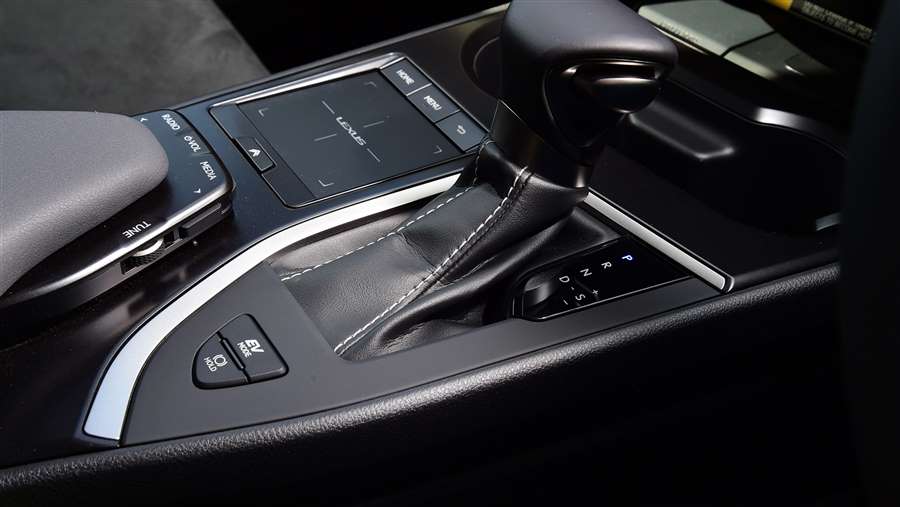
The UX model is available with a Tech & Sound Pack that equips the vehicle with the Mark Levinson audio system, head-up display, wireless charger and power-adjustable front seats and steering wheel.
The F Sport model is available with a Takumi Pack, which includes everything in the Premium Plus and Tech & Safety Packs, together with front seat ventilation, the Mark Levinson audio system, a sunroof and 360-degree camera. If you want to inject some extra flair, there's also a new ‘Cobalt’ blue trim colour for 2020, as well as an ‘F White’ colour scheme with contrasting black and white leather for the seats and dashboard.
Practicality & boot space
The Lexus UX is reasonably spacious for passengers, but boot space is tight
The restrictions enforced by the Lexus UX's compact overall dimensions presented its designers with a major challenge when it came to interior packaging, and the sleek crossover is further hamstrung by its low, curvaceous roofline. As a result, although space inside is adequate, there's no mistaking the Lexus UX for a versatile family car.
Lexus UX interior space & storage
Front-seat passengers get by far the best deal inside the UX, where the wraparound dashboard gives the driver a cocooned feeling without claustrophobia setting in. There's more headroom than you might expect, thanks largely to the low-set seats.
The same is true in the back, but the narrow windows don't let a great deal of light in. It means rear-seat passengers get the impression of there being less space than there actually is, and most will actually find knee and headroom adequate.
Boot space
With a high floor, boot space is just 320 litres - a small size for the class and 150 litres less than the BMW X2 offers. Things get even worse with four-wheel drive fitted, because the extra mechanical hardware reduces boot space to 283 litres - less than you get in a Ford Fiesta.
The rear seats fold with a 60:40 split should you need to expand the boot without passengers on board, but the steeply raked rear windscreen puts paid to the notion of carrying bulky items.
Source: carbayer.com
Lexus RX L review
Seven-seater version of beautifully built Lexus hybrid SUV
The Lexus RX L is a seven-seated version of the Lexus RX, a large SUV that's been offering buyers the choice of hybrid capability for 20 years.
Hybrid SUVs scything through big cities might be commonplace now, but it wasn't the case in the late nineties. Then Lexus came along with the original RX, changing the way posh city dwellers drive. Now people could choose a large car with an imposing seating position that was also kind to the environment.
The RX is equally as good away from tight city streets, and now it has another string to its bow - seven seats, in the form of this RX L.
The RXL goes toe-to-toe with the likes of the Audi Q7, Volvo XC90, BMW X5 and Range Rover Sport. It's pitched as a standalone model that sits alongside the five-door RX. Lexus reckons two thirds of customers will choose five seats, while one third will opt for seven.
Lexus RX 450hL: the seven-seater SUV
Only one variant is sold in the UK: the RX 450h L. The h in that name signifies that it’s the hybrid petrol-electric version. Other markets elsewhere in Europe offer a petrol-only powertrain, but it’s not available here.
The 3.5-litre V6 petrol engine is mated to an electric motor on each axle and the RX L constantly juggles between the power sources; there is an EV Mode button on the centre console that drivers can select if they want to whirr around town silently for ultimate eco-warrior status. Just be mindful that you can only drive for a couple of miles before the small battery will be depleted and the engine kicks in to take over.
Do I have to plug in my Lexus RX L?
No - it is not a plug-in hybrid electric vehicle, or PHEV. Instead, the V6 petrol provides charge to the nickel metal hydride battery pack under the rear seats and this is why Lexus has started referring to the technology as a self-charging hybrid.
The system works well and there is little complication for drivers to tackle; merely slot the automatic transmission into D for Drive and set off. Electronics constantly shuffle the power supply, the only indication of what’s happening being the electronic display between the speedo and power supply dial.
Lexus RX 450hL prices and specs
With only a single engine available, the RX L price structure is very simple. UK prices start from just under £53,000, around £1,300 more expensive than the regular five-seat RX.
Choose from two trim levels: RX 450hL and Takumi.
RX 450hL 20-inch alloys, keyless entry, 12.3-inch infotainment with Apple CarPlay and Android Auto, electric tailgate
Takumi (in addition to standard car) Heated/ventilated front seats, 360-degree camera, Mark Levinson Surround Sound System
Lexus RX L review: what's it like to drive?
It’s important to realise that the RX 450hL shares the same wheelbase as the regular RX - the underlying oily bits are the same and there is no change to the distance between the wheels. Instead, the extra space comes from an elongated rear end, stretched by 110mm.
So, it drives in a very similar fashion to the five-seat car. The Lexus RX L is now a long vehicle at precisely five metres and heavy at around 2.2 tonnes, but it never feels unwieldy. Although the parking sensors and cameras are really appreciated when squeezing into tight spaces.
On the road, the RX 450hL has a laid-back gait: this is an extremely relaxing car to drive, with impeccable refinement, whisper-quiet powertrain and little wind noise (double glazing helps here). At a cruise, it is extremely impressive.
However, that peace is disturbed somewhat if you go for an overtake or drive up a steep hill; the Continuously Variable Transmission (CVT) gearbox sends the revs soaring sky-high as the V6 engine wakes up and provides its thrust. In fairness, the powertrain is much better than earlier iterations and in day-to-day driving, it’s much more relaxed.
It is impressive how frequently the car runs on electric power alone; a green EV logo lights up in the dashboard and you simply cruise silently for long stretches in and out of town, virtual halo firmly intact above your head.
If you want a dynamic, more involving drive, we’d look at the more engaging BMW X5 or Range Rover Sport; the RX is somewhat detached and sterile, even in Sport mode. But we commend its focus on chilled-out comfort: it’s bang-on for the Lexus family character and SUV buyers favouring comfort and premium luxury over cornering prowess will love it.
Practicality and those seven seats
Lexus RX 450 hL rear-most seats are good enough for occasional useEnlarge0videoEnlarge41photo
Accommodation in the front and middle rows is generous. There is no transmission tunnel at all for the second row, meaning lots of space for feet. Headroom is plentiful too.
There is an impressive 150mm of fore-aft adjustment of the middle row, letting you juggle space for luggage and limbs. Crucially, it also means you can slide the bench forwards to ease entry to the third row (an easy, one-handed affair).
Seats six and seven fold up and down electrically and are best reserved for children or small adults on short journeys. Room for head and legs is tight, though competitive with the class norm, and there’s third-row climate control as standard so kids in the back can be as cool or hot as they wish.
Perhaps more impressive than back-row accommodation is luggage space: unlike some seven-seaters, the boot is a decent size at 495 litres when set up as a five-seater. Pop down both rows of rear seats and the cargo bay stretches to an echoing 966 litres. With all seven pews up, there is 176 litres worth of space in the boot.
Build quality is exceptional throughout; Lexus has interior quality licked and we have every reason to expect the RX L to be a safe and trouble-free long-term proposition.
Lexus RX 450hL emissions and running costs
This is one of the RX’s party tricks: its hybrid powertrain brings with it devilishly attractive tax and running cost advantages, especially if you’re a company car driver. There is no diesel option at all.
Claimed CO2 emissions start at 185g/km, rising to 186g/km for models with a sunroof. Fuel economy meanwhile is stated at 34.4mpg. In reality, we expect 40+mpg to be a feasible result in typical driving.
Be warned that service intervals are shorter than the German competition’s: you’ll have to visit your local Lexus dealership every 10,000 miles or annually. Insurance group rankings vary between group 41 and 43, depending on which spec level you plump for.
Lexus RX 450hL infotainment
The Lexus received an updated infotainment system in 2019 - something it desperately needed. The old one was outdated and fiddly becuase it used a mouse-operated multi-controller system.
Luckily, the new system is a lot easier. The 12.3-inch central touchscreen is methodical in design, while if you don't want to use that on the move there's a trackpad with haptic feedback like you'd find on a high-end phone.
It all works effortlessly, although there are lots and lots of options we suspect many people may not ever use, and it's still not as easy to use as traditional systems like you'll find in the BMW X5. At least the Lexus has physical buttons for the heating system - unlike the Volvo XC90.
Phone connectivity is also here with Apple CarPlay and Android Auto, both of which basically make the car's infotainment system work like your phone.
Source: parkers.co.uk

